Looking for Listrak alternatives in 2025? Compare 7 top eCommerce marketing platforms including Maestra, Klaviyo, Omnisend, Attentive, and more. Find the best tool for your email, SMS, and loyalty campaigns.
7 Listrak Alternatives 2025
In 2025, many eCommerce marketers are re-evaluating their relationship with Listrak.
Below, we break down 7 top Listrak alternatives—including industry leaders and up-and-comers—that eCommerce store owners should evaluate this year. Each offers unique strengths, whether it’s better ease-of-use, innovative features, or budget-friendly plans.
Listrak overview
Listrak is a long-standing omnichannel marketing platform built for retail and eCommerce brands. It offers a suite of tools including email marketing, SMS, push notifications, identity resolution, predictive product recommendations, and customer journey automation. With deep integrations into platforms like Shopify and Magento, Listrak is known for serving mid-market to enterprise retailers that want to personalize communications across multiple channels.
One of Listrak’s core strengths is its omnichannel approach. Through its “Journey Hub, ” marketers can build complex, multi-step campaigns that trigger across email, SMS, and other channels based on customer behavior and lifecycle stage. For companies looking to unify communication touchpoints under one system, this integrated orchestration offers clear value—particularly in retail envronments with long buying cycles or frequent promotions.
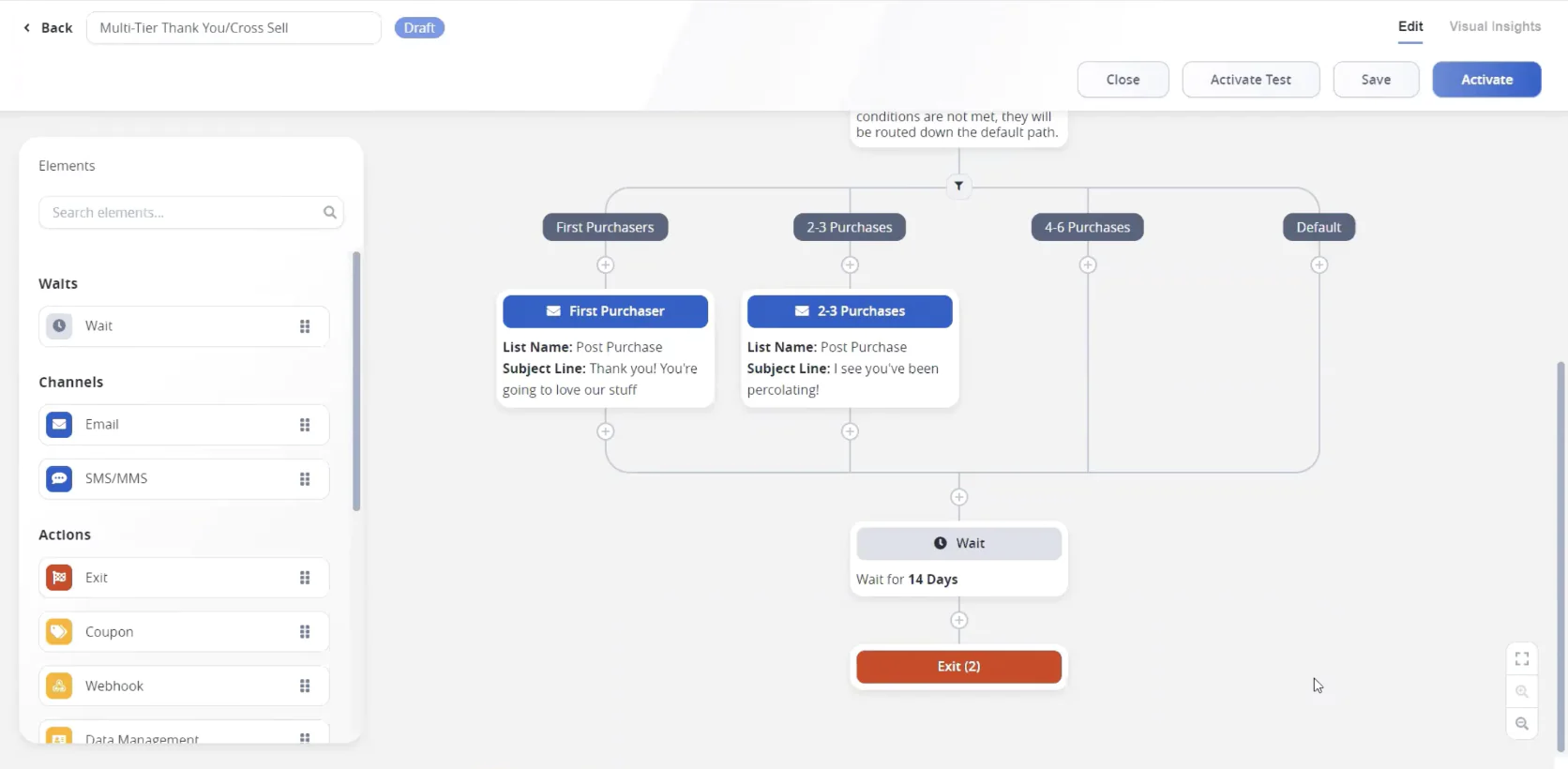
Listrack’s Journey Hub
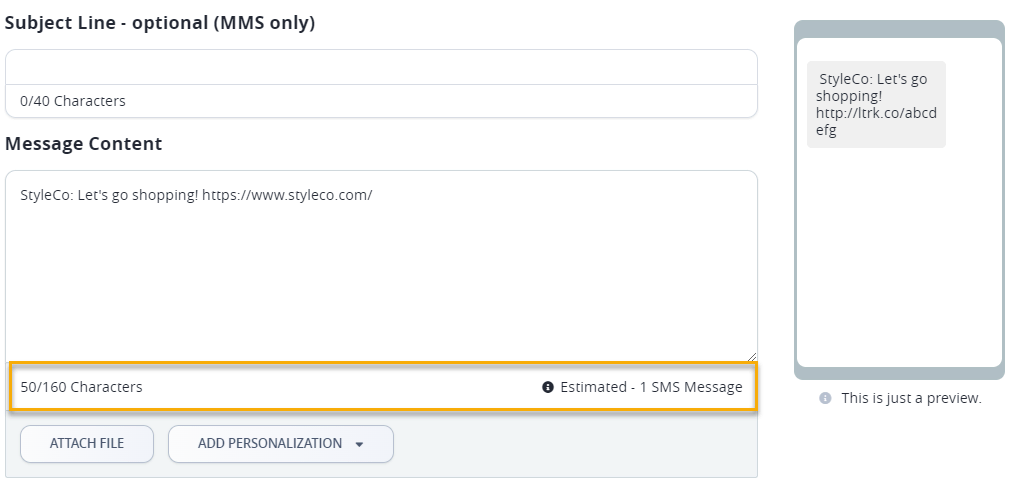
Listrak’s SMS and MMS builder
Another strength lies in Listrak’s commerce-focused capabilities, especially for merchandising-heavy brands. The platform includes built-in predictive product recommendations, dynamic content blocks, and integrations with leading eCommerce platforms like Shopify, Magento, and Salesforce Commerce Cloud. These features make it easier to deliver personalized offers based on browsing or purchasing behavior.
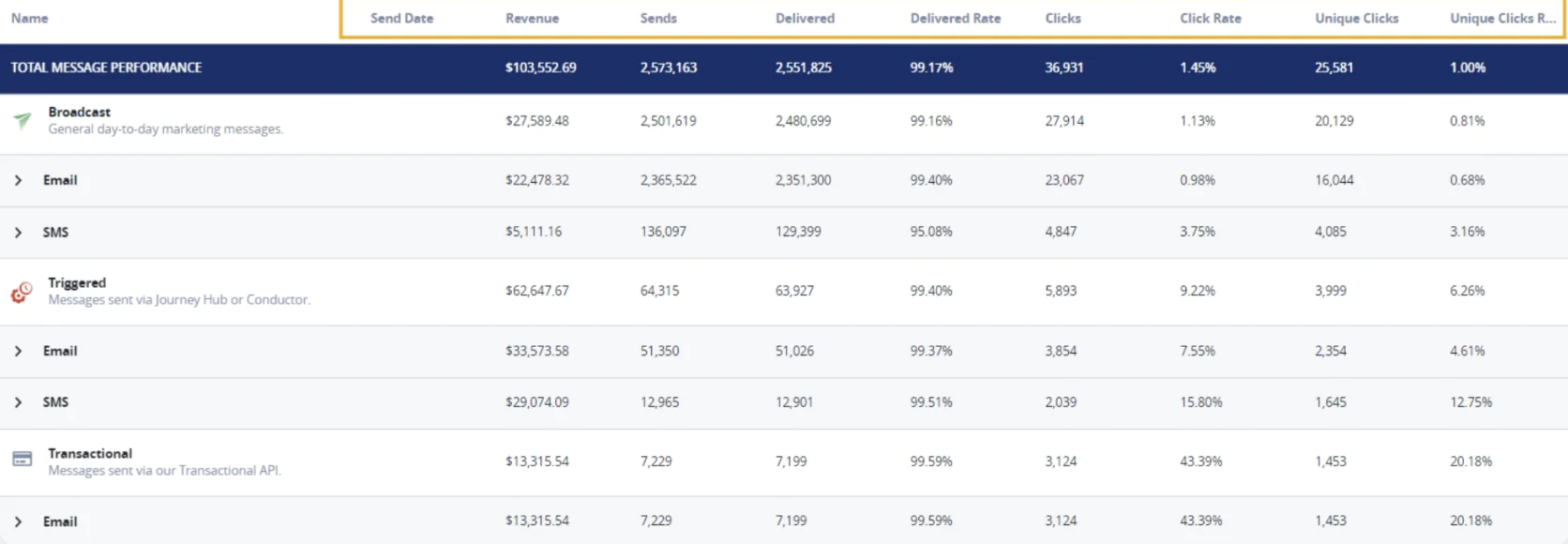
Listrak’s performance summary dashboard
Additionally, Listrak’s identity resolution tools help marketers recognize anonymous traffic and tie engagement back to known customers, helping fuel more relevant campaigns over time.
Finally, Listrak’s long tenure in the space gives it a level of credibility and proven infrastructure that appeals to traditional retail teams. For brands already operating at scale, the platform offers high-volume sending, dedicated IPs, and a suite of deliverability tools that support complex enterprise use cases. In the right hands—and with proper onboarding—Listrak can be a powerful toolset for executing large, coordinated marketing strategies.
Why to Consider Alternatives
While Listrak has long been a staple for email and SMS marketing, users report growing usability challenges, rising pricing concerns, and customer support issues that make them wonder if it’s time for a change.
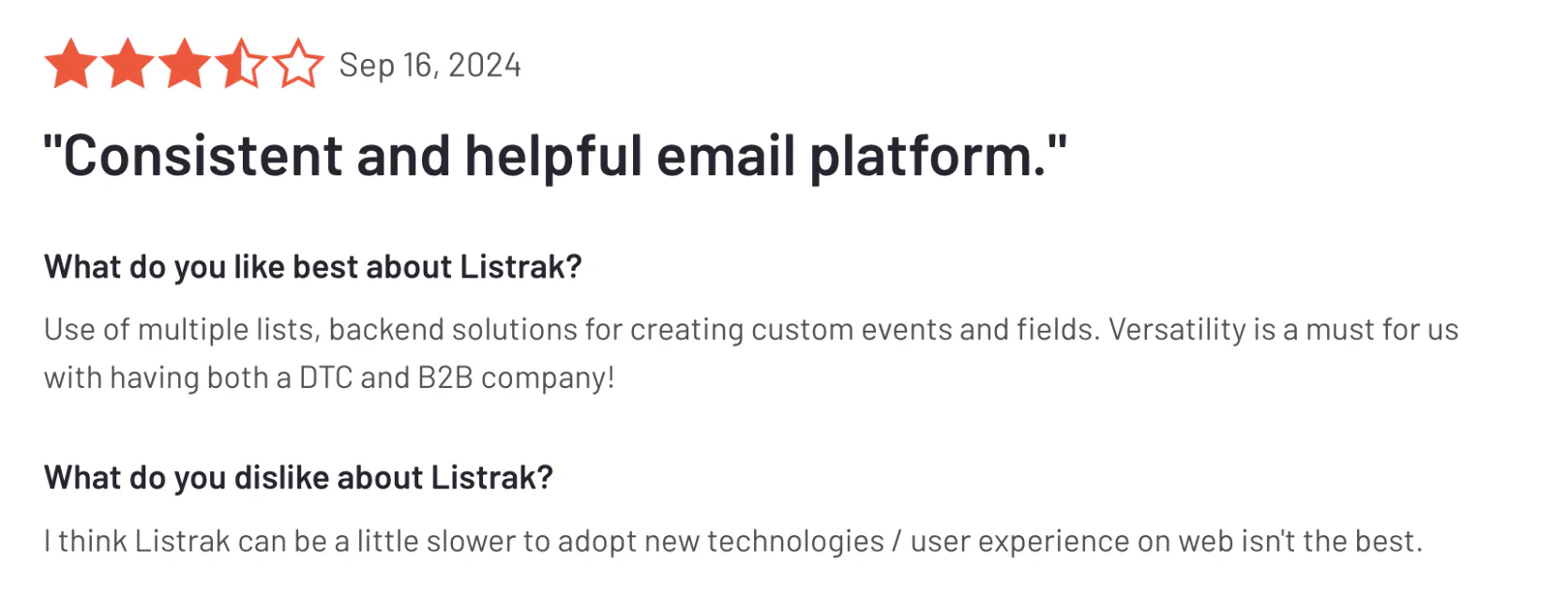
Listrak’s interface can feel dated and complex to new users, its pricing often comes with add-on fees (every extra feature seems to have a separate cost), and support quality has been described as inconsistent by some retailers.
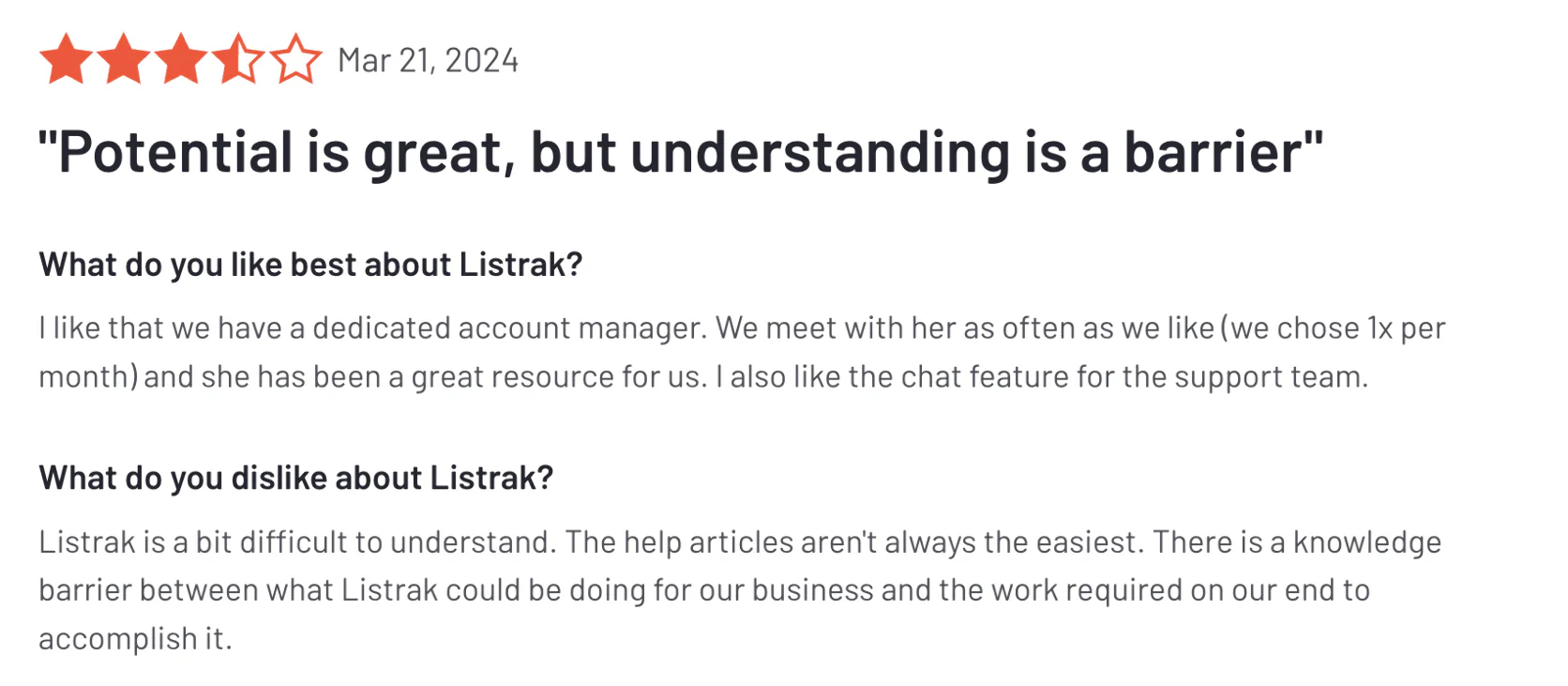
If you’re feeling locked in or underserved, you’re not alone. The good news is that there are several modern platforms that can replace or even outperform Listrak.
The Alternatives at a Glance
Tool
Best For
Key Features
Price Range
Maestra
Growing SMB, mid-size & enterprise brands seeking an all-in-one modern platform
• Real-time CDP for advanced segmentation
• Omnichannel campaigns (Email, SMS, push, loyalty)
• AI-driven personalization & product recommendations
• Dedicated Customer Success onboarding
• Omnichannel campaigns (Email, SMS, push, loyalty)
• AI-driven personalization & product recommendations
• Dedicated Customer Success onboarding
From ~$2,990/month (all features + CSM)
Klaviyo
Data-driven eCommerce teams focused on email & SMS
• Pre-built flows (cart abandonment, etc.)
• Powerful segmentation & A/B testing
• Deep Shopify/Magento integration
• Predictive analytics (LTV, churn)
• Powerful segmentation & A/B testing
• Deep Shopify/Magento integration
• Predictive analytics (LTV, churn)
Paid plans from ~$20/month (scales with list size)
Omnisend
Small to mid-sized merchants on a budget
• Email, SMS, & push in one platform
• Easy drag‑and‑drop email builder
• Pre-built automations for cart recovery
• 24/7 support (even on free plan)
• Easy drag‑and‑drop email builder
• Pre-built automations for cart recovery
• 24/7 support (even on free plan)
Pro plan from $59/month
Postscript
Shopify stores wanting a dedicated SMS solution
• SMS/MMS campaigns & automated flows
• Two-way messaging and replies
• Pop-up tools for phone capture
• Strong Shopify integration
• Two-way messaging and replies
• Pop-up tools for phone capture
• Strong Shopify integration
Free to install; pay-as-you-go ($25/mo min, ~$0.015/SMS)
Attentive
Large brands prioritizing SMS engagement & white-glove support
• Enterprise-grade SMS marketing suite
• AI-powered text personalization
• Advanced audience insights
• Managed strategy & onboarding support
• AI-powered text personalization
• Advanced audience insights
• Managed strategy & onboarding support
Custom pricing (often ~$300+/month + usage fees)
SMSBump
Shopify merchants seeking easy SMS (with Yotpo ecosystem)
• SMS/MMS campaigns and automation
• Native Shopify and Yotpo integration
• TCPA/GDPR compliance tools
• Loyalty and review integration triggers
• Native Shopify and Yotpo integration
• TCPA/GDPR compliance tools
• Loyalty and review integration triggers
Pay-as-you-go (≈$0.007/SMS); optional plans from ~$19–$59/month for extras
Active Campaign
Businesses needing robust automation + CRM integration
• Visual automation workflow builder
• Email marketing with segmentation
• Built-in CRM and lead scoring
• SMS integration via add-on
• Email marketing with segmentation
• Built-in CRM and lead scoring
• SMS integration via add-on
No free plan; starts ~$29/month (for ~1k contacts) + SMS add-on fees
Now, let’s dive into each of these tools in detail. We’ll explore their strengths, weaknesses, and how they compare to Listrak—and to Maestra, which is a standout contender for those seeking a modern, affordable, user-friendly alternative.
Tool #1: Maestra
Best for: Ambitious brands that want full-funnel marketing in one unified platform (email, SMS, web personalization, loyalty, and more).
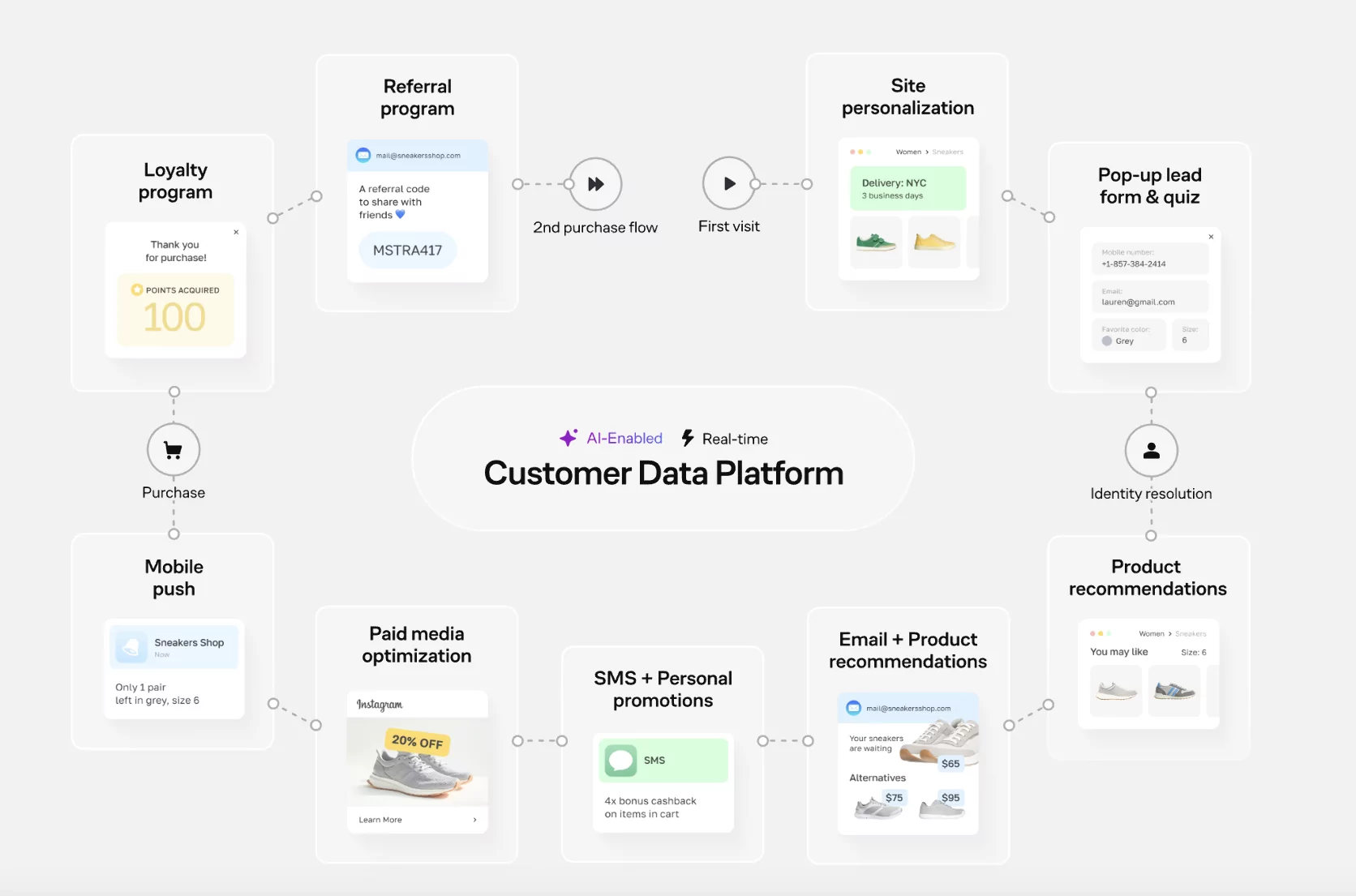
Maestra is an all-in-one omnichannel marketing platform built for e-commerce marketers ready to leave cobbled-together tools behind. It combines email, SMS, push notifications, onsite personalization, and even a loyalty/rewards program engine in one hub.
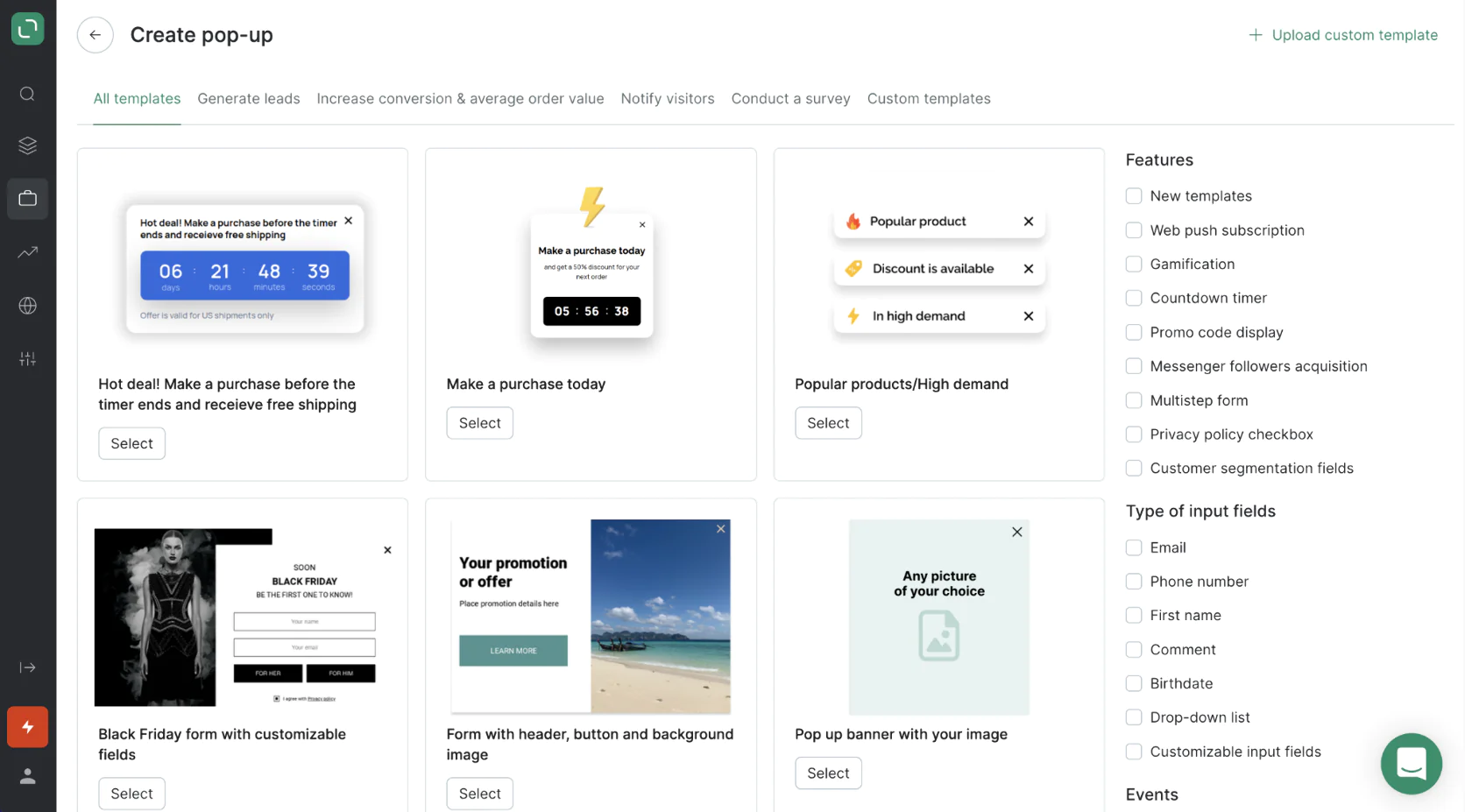
Maestra’s pop-up form templates
With Maestra, you get a real-time unified customer profile for each shopper, letting you orchestrate campaigns that adapt on the fly. Its mission is to make sophisticated marketing feel straightforward—so brands can create revenue-driving customer journeys without needing a PhD in data science (or a squad of engineers).
Key Features:
- Unified Omnichannel Automation enables seamless campaign orchestration across email, SMS, web, and mobile from a single dashboard. Create sophisticated customer journeys that respond to real-time behavior, delivering the right message through the optimal channel at the perfect moment.
- Advanced Customer Data Platform unifies online and offline data, enabling granular segmentation down to individual interactions. This powers truly personalized experiences based on complete customer understanding.
- Built-in Loyalty & Referral Programs eliminate the need for separate platforms. Reward customers with points, VIP tiers, and referral incentives—all managed within the same system that handles your messaging.
- Dynamic Website Personalization creates unique experiences for each visitor. Greet returning customers by name, showcase relevant products based on browsing history, and trigger targeted offers powered by AI-driven personalization.
- Intelligent Promotions Engine streamlines discount management with automated distribution, redemption tracking, and expiration settings targeted precisely to your defined segments.
- White-Glove Support pairs every client with a dedicated Customer Success Manager who guides implementation, strategy development, and technical integration—offering exceptional service rarely found at this price point.
Strengths and weaknesses
Maestra’s biggest strength is making every customer interaction feel personal at scale. It’s not about blasting more messages—it’s about sending the right message at the right time on the right channel. Users love the drag-and-drop flow builder that makes designing complex cross-channel automations intuitive.
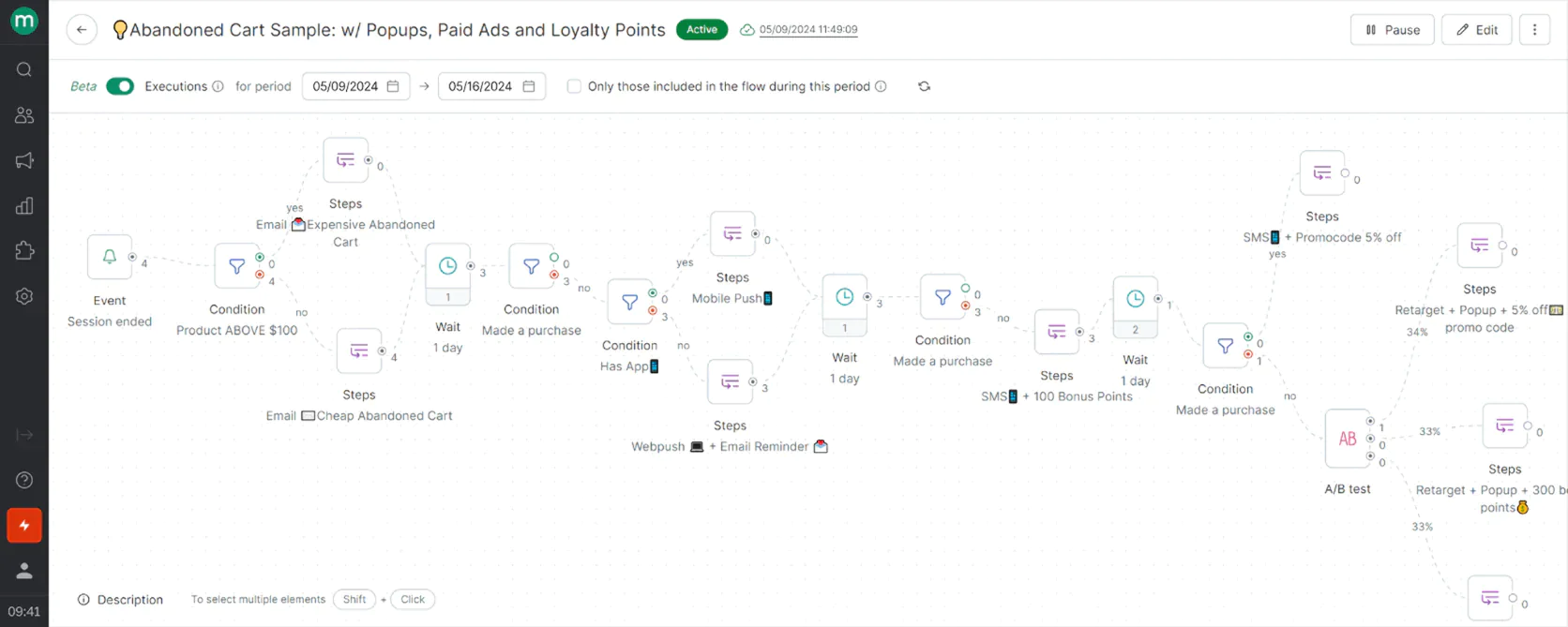
Maestra’s omnichannel flow builder interface
You can set up hyper-targeted flows (email/SMS sequences, on-site popups, etc.) triggered by real-time shopper behavior—for example, a price-drop SMS sent if a VIP customer views an item and it goes on sale, followed by an email with a loyalty points offer if they don’t purchase. This level of real-time trigger and personalization is where Maestra truly shines.
Marketers also praise the dynamic email composer that ensures each email is uniquely tailored (product recommendations, content blocks, etc.) without heavy lifting—and importantly, those emails load fast and avoid Gmail clipping.
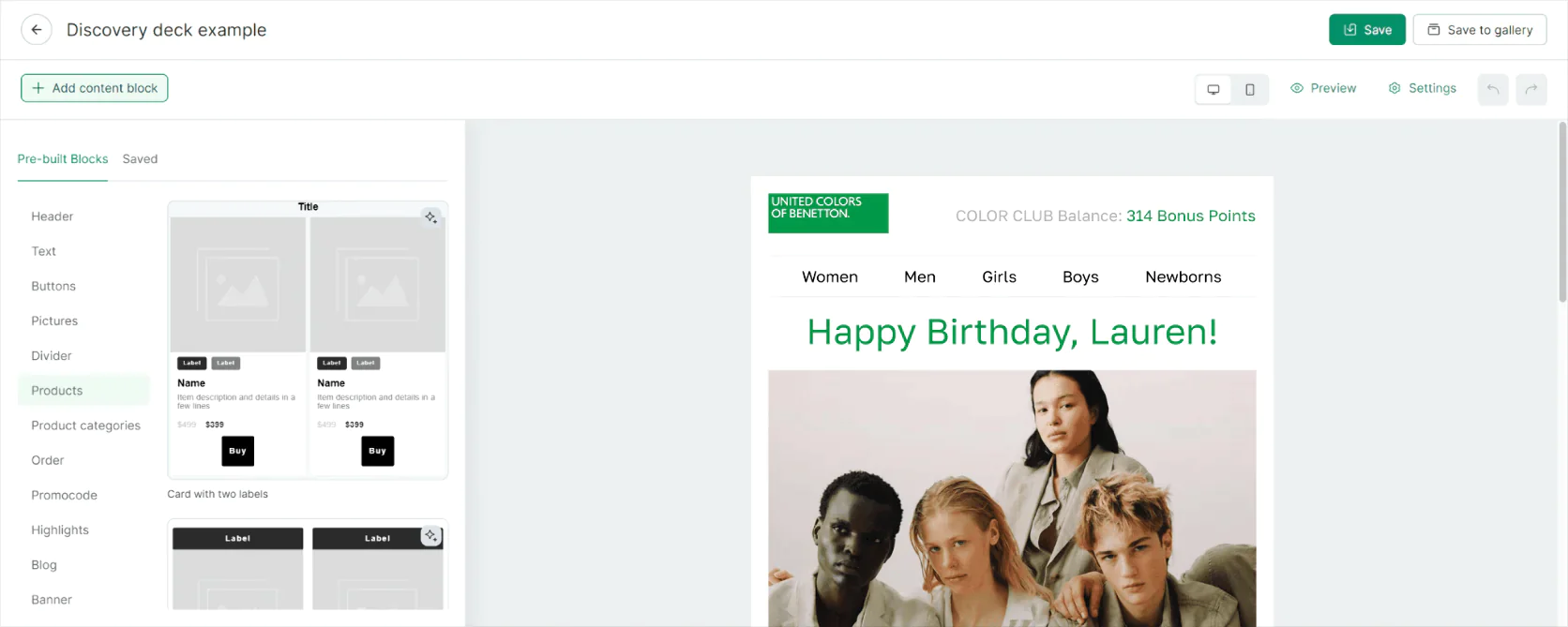
Maestra’s visual email composer
When it comes to drawbacks, Maestra doesn’t give you much to gripe about in functionality—but it is an investment. Pricing starts around $2,990 per month, which means it’s aimed at growing SMBs, mid-market and enterprise brands. There’s no free plan or pay-as-you-go option, but integration period is free.
The price includes a lot (the full suite of channels, advanced features, and dedicated support), whereas some competitors charge extra for each module or high-volume usage. So, it might be easier to achieve high ROI with Maestra thanks to having a full range of tools.
Another area for improvement is user-generated content integration—Maestra can incentivize reviews and leverage social proof, but it doesn’t have built-in review management/display tools. You’d integrate a Yotpo or similar for that.
Overall, the weaknesses are mostly about very advanced niche features; the platform itself has a robust toolkit that’s consistently praised for reliability and innovation.
Compared to Listrak
Listrak and Maestra both position themselves as omnichannel marketing solutions for retailers, but they take very different approaches. Usability is a key separator—Listrak’s interface can feel clunky and dated, while Maestra offers a more modern, streamlined UX that newcomers pick up quickly (especially with Maestra’s customer success team that provides onboarding and takes care of integration).
Maestra also provides capabilities out-of-the-box that often require add-ons or integrations in Listrak. For example, Listrak offers segmentation and automation, but it relies on a lot of static list management and has limited real-time web personalization.
Maestra’s real-time CDP means data from all channels (site behavior, purchase history, email engagement, etc.) is unified and instantly usable to trigger campaigns. This enables far more dynamic marketing.
Another big difference is cost structure. Listrak typically requires a contractual commitment and charges extra for certain modules or message volumes. Many users feel nickel-and-dimed by Listrak’s add-on fees for “premium” features or higher send limits.
Maestra, while having a higher base price, includes the full suite and a dedicated success manager in that cost—so you’re getting email, SMS, push, personalization, loyalty, and more under one roof (and one price).
Think of Listrak as an older all-in-one that might still require piecemeal additions, whereas Maestra is a next-gen all-in-one with everything built-in. For a brand that is frustrated by Listrak’s support or slow feature development, Maestra also offers a more high-touch partnership.
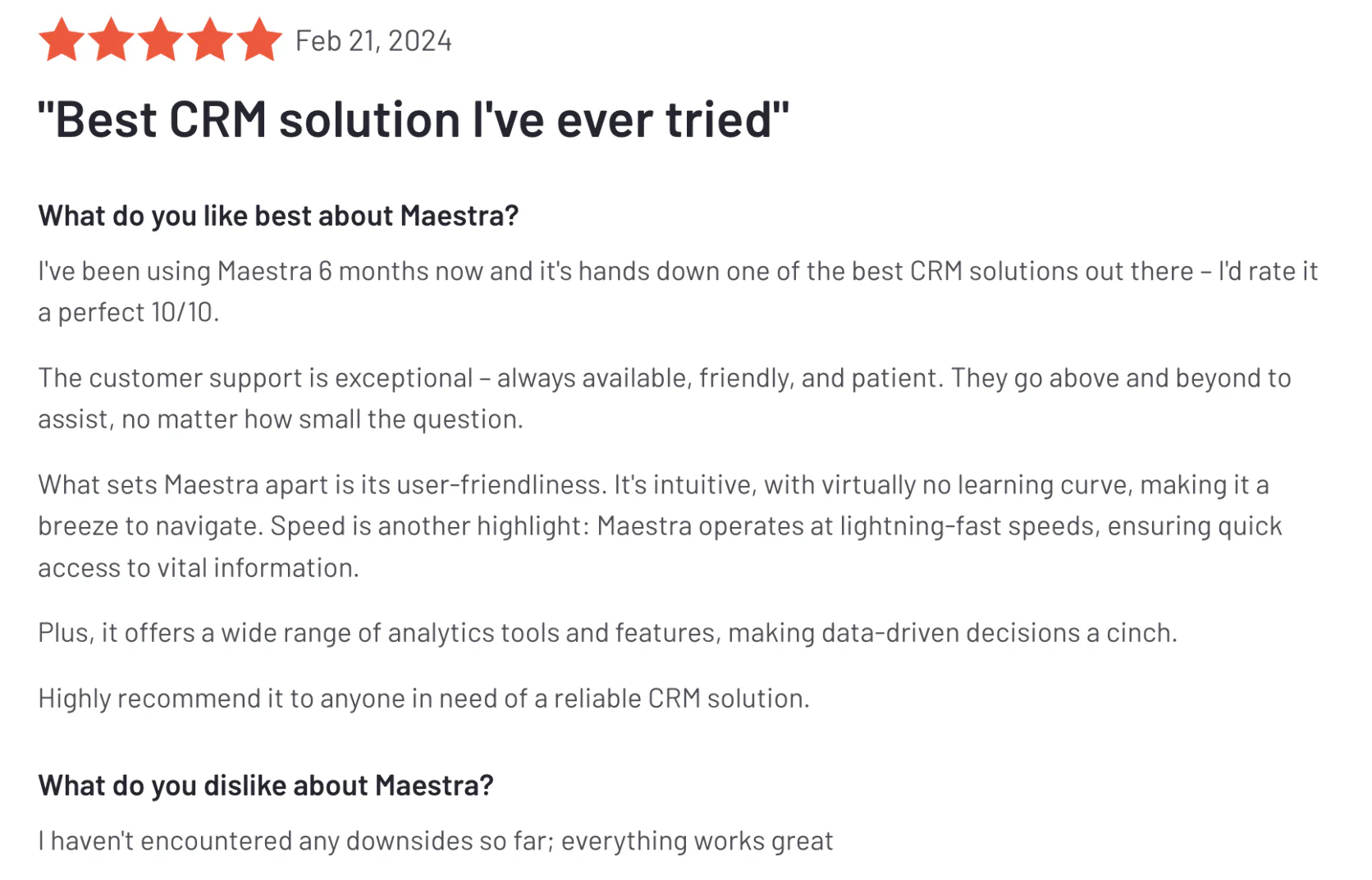
You’re not submitting help tickets into a void; you have a dedicated contact to ensure you’re successful. In short, Maestra is a compelling upgrade for those who find Listrak too rigid, too fragmented, or too opaque on pricing—it’s designed to eliminate those pain points with a unified, agile solution.
Tool #2: Klaviyo
Best for: DTC and eCommerce brands that want powerful email marketing with integrated SMS, and a platform that plays nicely with Shopify and other ecom tools.
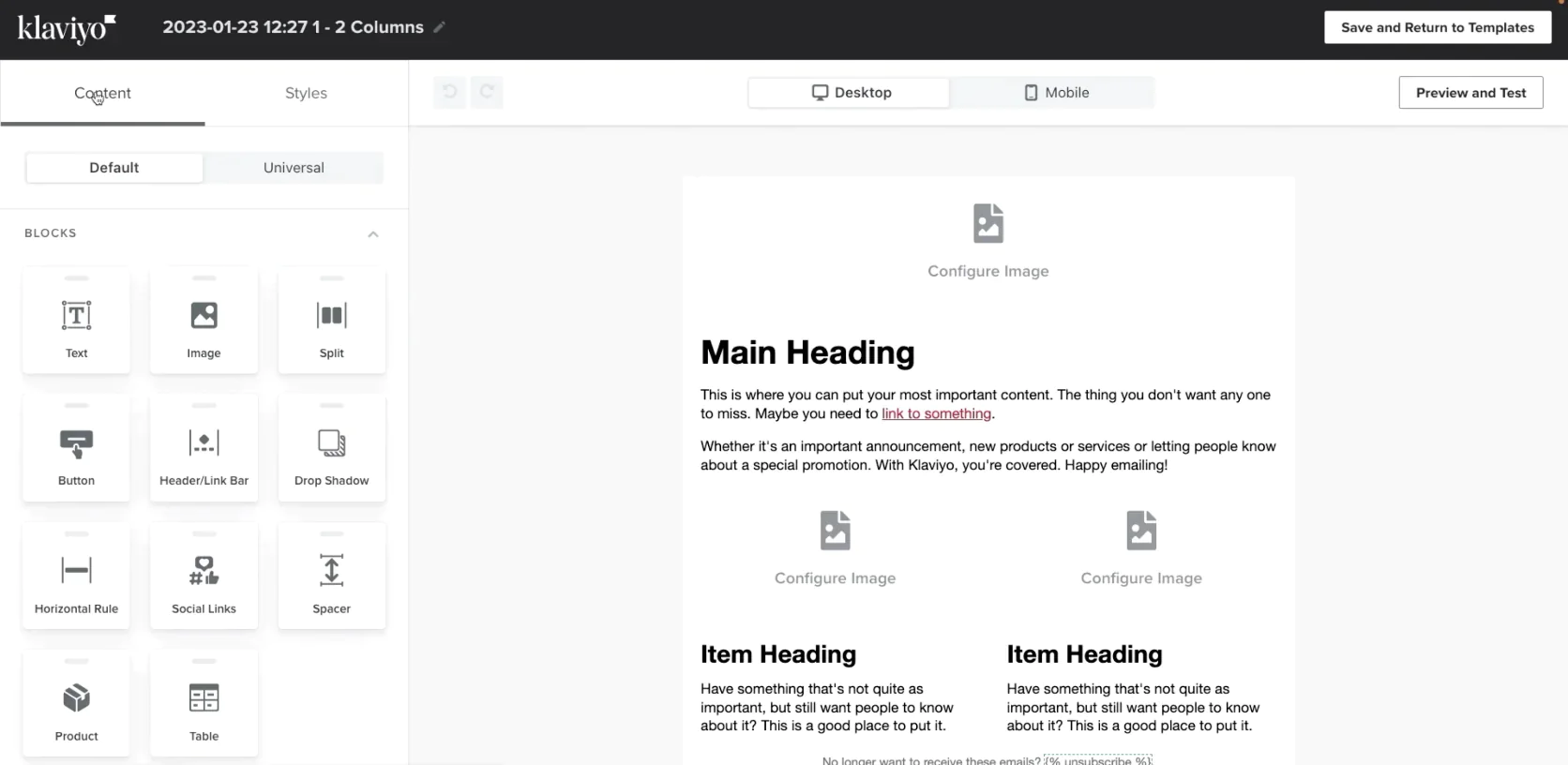
Klaviyo’s email composer
Klaviyo has become nearly synonymous with eCommerce email marketing. It’s a leading customer marketing platform built initially around email, now with SMS and push notifications in the mix. Thousands of Shopify stores (from small boutiques to big brands) rely on Klaviyo to send personalized newsletters, automated lifecycle emails, and text message campaigns.
The platform is known for its ease of use and deep integration with e-commerce data—you can easily pull in purchase history, product details, and site activity to drive your campaigns.
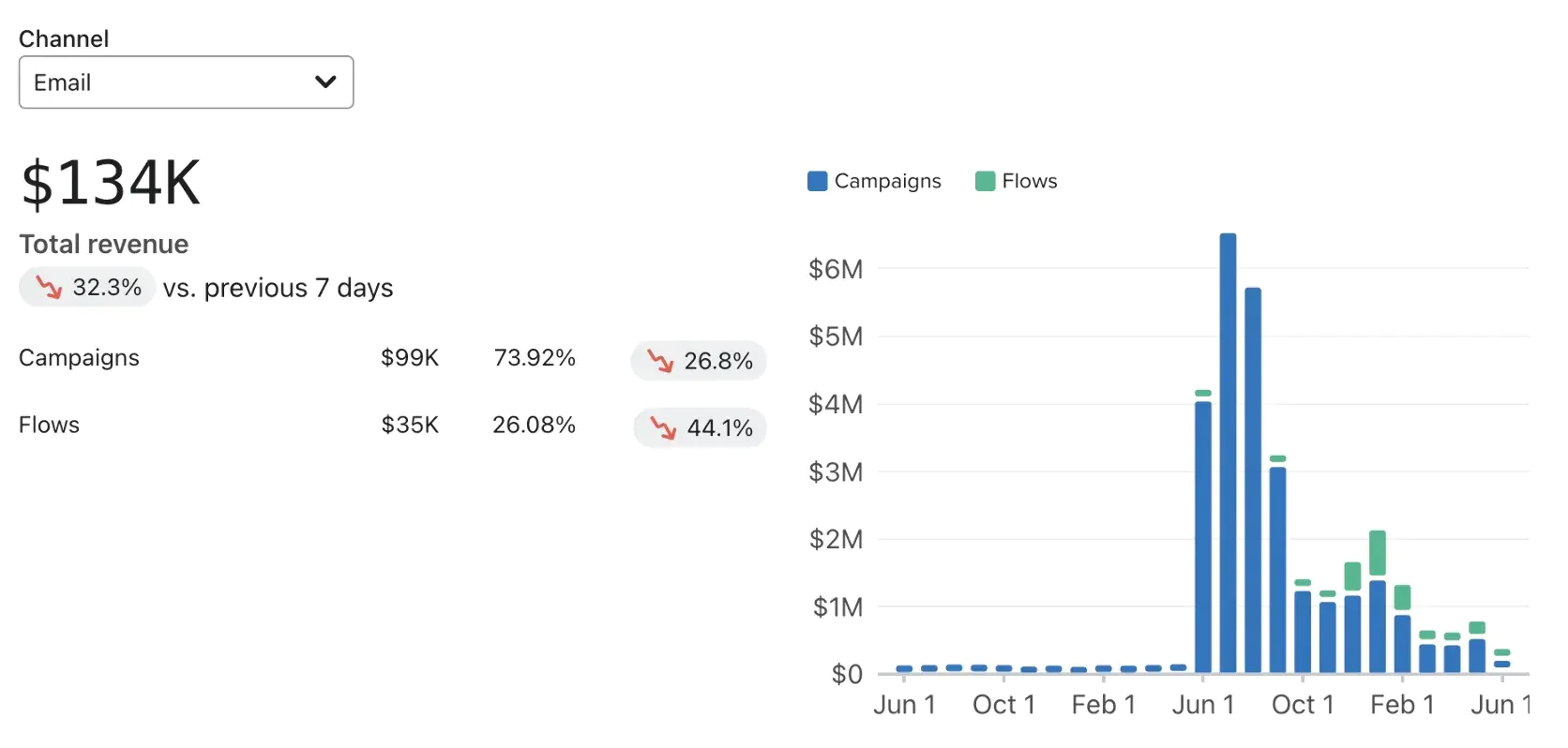
Fragment of Klaviyo’s business review dashboard
Klaviyo essentially acts as a B2C CRM + marketing automation tool, giving you a unified view of each customer and tools to engage them across channels.
Key Features:
- Pre-built automation flows for common scenarios—e.g. abandoned cart series, welcome series, post-purchase follow-ups—which you can plug-and-play or customize
- Advanced segmentation based on customer behavior, demographics, purchase patterns, engagement, and more (combine dozens of conditions to hyper-target)
- Email and SMS campaigns with a drag-and-drop editor and a rich template library (160+ email templates to get started)
- Integration ecosystem—one-click integrations with Shopify, BigCommerce, Magento, WooCommerce, and 300+ other apps, ensuring data (like order events) flows into Klaviyo in real time
- Analytics & reporting including revenue attribution for each campaign/flow, customer lifetime value predictions, and benchmarks against similar businesses
- A/B testing for subject lines, content, send time, etc., and even automated winner selection for campaigns
- SMS and push add-ons so you can manage text messaging and push notifications in the same platform (with compliance tools for opt-in)
Strengths and weaknesses
Klaviyo’s strength lies in its balance of power and usability. Marketers often commend how quick it is to get started—there’s a free tier (up to 250 contacts) that lets you try features, and the onboarding is quite friendly. The preset flows and templates mean you can start sending effective campaigns on day one.
You can get extremely granular, building segments like “VIP customers in California who bought in the last 30 days but haven’t clicked an email in 60 days.” This data-centric approach helps drive more personalized messaging than simpler email tools (like Mailchimp).
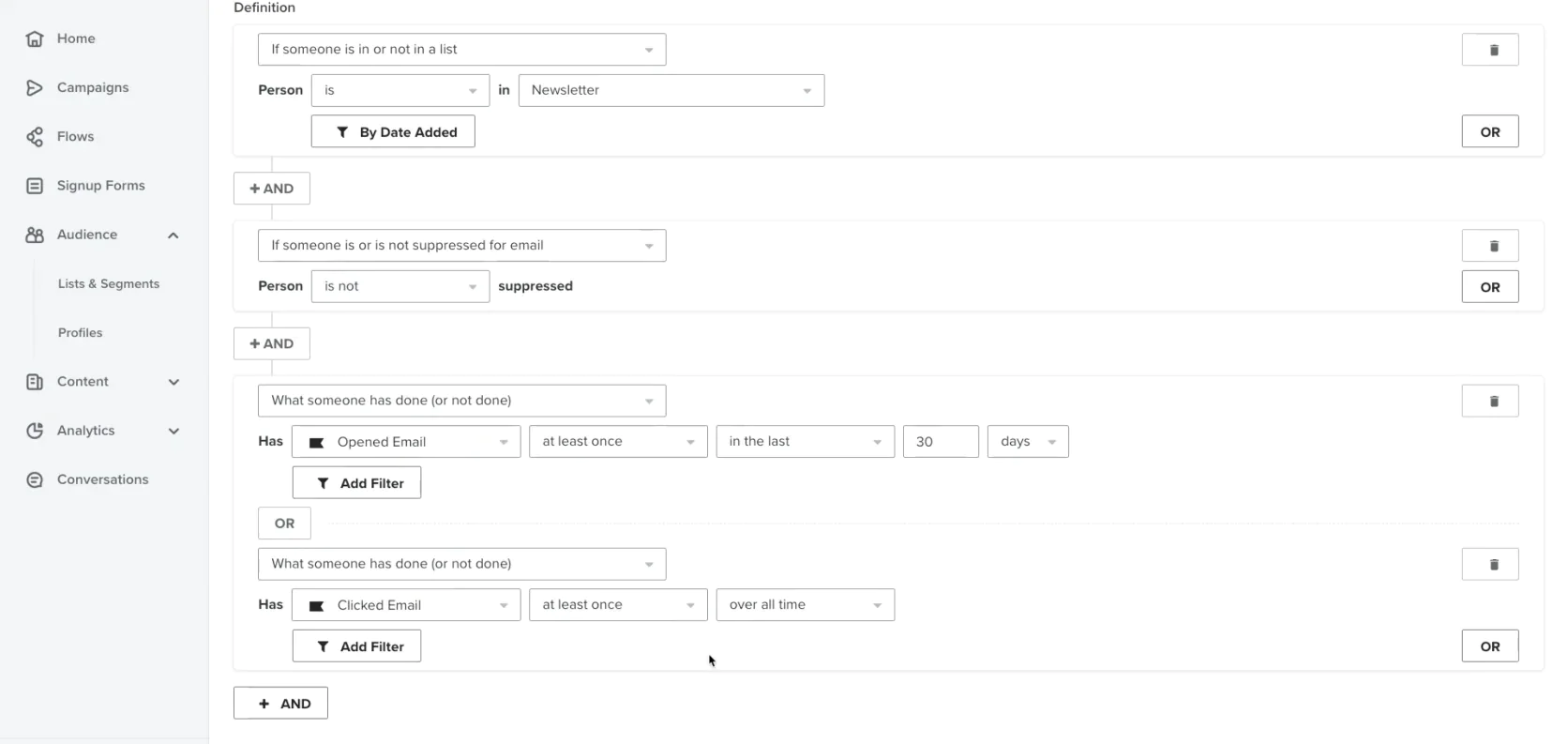
Klaviyo’s segment builder
Another strength is the Shopify integration—Klaviyo pulls in product catalogs, tags, and events seamlessly, which is why so many Shopify stores choose it.
The community and resources around Klaviyo are also great; because it’s so popular, there are many third-party guides, agencies, and experts proficient in it.
On the downside, Klaviyo can become pricey as your subscriber list grows. Its pricing is usage-based—you pay more as you have more contacts or send more messages—and some users find that at scale, Klaviyo ends up costing nearly as much as enterprise tools.
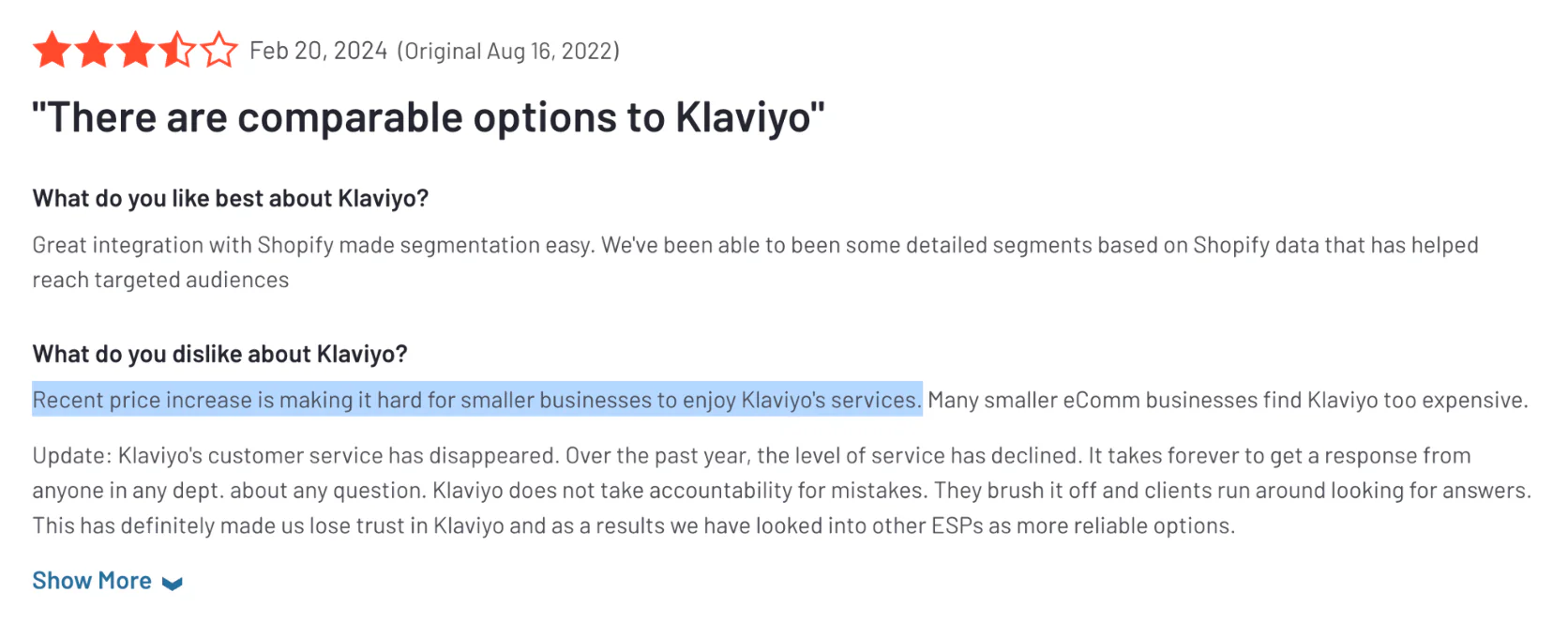
There’s also no built-in loyalty or review feature, so you’ll need additional apps for those (Klaviyo does integrate with loyalty programs and review platforms, but it’s not native).
In terms of features, Klaviyo’s focus is marketing communications; it doesn’t natively do on-site personalization beyond simple signup forms, and it lacks a built-in SMS concierge or advanced AI content generation (they have some predictive analytics, but not the AI SMS replies that specialist SMS platforms tout).
Support from Klaviyo is decent but not hands-on—standard email support unless you’re a big account.
In summary, Klaviyo’s weaknesses are mainly cost at scale and the fact that it’s not an all-in-one (it’s fantastic for email/SMS, but you’ll use other tools for loyalty, reviews, etc.).
Compared to Listrak
Many mid-market brands find themselves comparing Listrak vs Klaviyo. The two can accomplish similar core goals (email & SMS marketing automation), but there are notable differences.
Ease of use is a big one: Klaviyo generally wins on having a more modern, intuitive interface. If you have a lean team or less technical expertise, Klaviyo’s learning curve is gentle—whereas Listrak, while improved over the years, may feel more old-school in design and workflows.
Flexibility is another factor. Listrak often appeals to larger retailers who want very tailored solutions and are okay with heavy customization (or even custom scripts). Klaviyo offers a lot of customization but within a more standardized framework. For example, Listrak can do complex multi-stage campaigns and has some unique features like predictive product recommendations, but so does Klaviyo—and Klaviyo users can often set things up without a developer, using the built-in recipes.
When it comes to pricing and scalability, the story is nuanced. Listrak typically involves a committed contract (often starting at a few hundred to thousand dollars a month, depending on list size and features) and can actually be more expensive for smaller lists. Klaviyo starts cheap (or free) and scales up; for small businesses, Klaviyo is almost always more affordable. However, if you’re a very large sender (hundreds of thousands of contacts), Klaviyo’s monthly bills can rival Listrak’s, and Listrak might negotiate a volume deal.
One more consideration is channel scope: Listrak’s platform includes web push and some on-site capabilities and identity resolution tools, whereas Klaviyo sticks mostly to messaging (email/SMS). If you needed, say, integrated print mail or complex in-store tie-ins, Listrak’s heritage in retail might have an edge.
But for most eCommerce brands, Klaviyo covers the bases more elegantly. In short, Klaviyo is often favored by those who found Listrak too cumbersome or costly, especially in the Shopify ecosystem. It provides 80-90% of the functionality in a more self-service, SMB-friendly package, albeit without some of the bespoke solutions a larger player like Listrak can offer.
Compared to Maestra
Klaviyo and Maestra can both power email and SMS campaigns, but they occupy different spheres in terms of breadth of features and service. Think of Klaviyo as a specialized toolkit for messaging, whereas Maestra is a complete marketing hub. For instance, Klaviyo doesn’t include a loyalty program module—you’d integrate something like Smile.io to run loyalty. Maestra has loyalty baked in, so those loyalty points can directly trigger emails/SMS or personalize site content.
Similarly, Klaviyo doesn’t do on-site personalization beyond basic form targeting, whereas Maestra can dynamically change site banners, product recommendations, etc., based on user data.
Another distinction is data handling. Klaviyo recently started branding itself as a CDP for B2C, and it does store a lot of customer data and events, but its real-time capabilities are limited to what’s within the app’s scope (email/SMS behavior, some web tracking). Maestra’s dedicated CDP is more robust, ingesting streaming events from multiple sources and acting on them immediately across channels.
What this means in practice: a scenario like triggering a push notification in under a minute when a VIP customer views a product twice and doesn’t buy is Maestra’s bread and butter. With Klaviyo, you’d capture the event but might not have as immediate or flexible a trigger without custom code.
On ease and cost, Klaviyo is easier to start with for small teams and cheaper at first. However, as you layer on needs—say you add an SMS tool, a separate loyalty platform, a personalization engine—you might end up with a higher total cost (and more complexity) in the Klaviyo-plus-addons approach. Maestra consolidates those, which can be more efficient for a larger or growing operation.
Support is also a differentiator: Klaviyo offers support, but it’s not typically one-on-one proactive coaching. Maestra includes a CSM who proactively helps optimize your marketing. If you’re a growing brand that has outgrown what Klaviyo can do (or are tired of stitching together 5 apps), Maestra is a logical step up—providing more capabilities under one roof.
Conversely, if you’re just starting out or only need email/SMS, Klaviyo might be perfectly sufficient without the heft (and cost) of an enterprise solution. Both are excellent, but Maestra aims higher on the value chain, covering not just messaging but the entire personalized customer journey in one platform.
Tool #3: Omnisend
Best for: Budget-conscious eCommerce stores that want an easy-to-use email & SMS combo, especially those on Shopify or WooCommerce looking for a step up from basic tools.
Omnisend is an eCommerce-focused marketing platform that combines email, SMS, and even push notifications. It carved out a strong niche by offering an affordable, user-friendly alternative to heavier systems. Omnisend is particularly popular among smaller and mid-sized online retailers—over 90,000 brands use it, according to their site—thanks to its generous free plan and templates geared toward quick results.
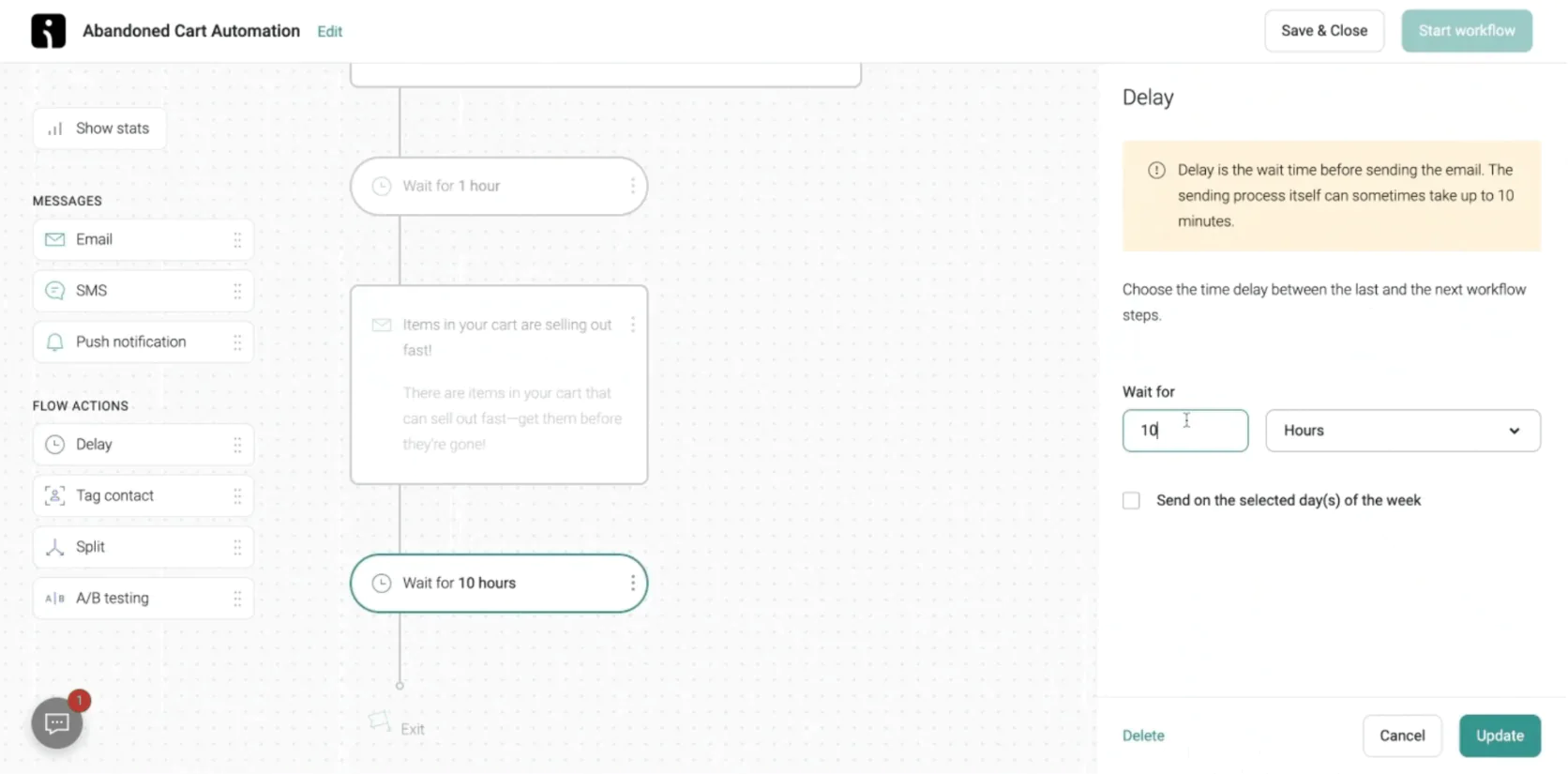
Omnisend’s pre-build abandoned cart automation
If you’re coming from a simple email tool (like Mailchimp) and need more automation, or if you find Klaviyo too pricey, Omnisend is often the next stop. It emphasizes pre-built workflows and templates so you can set and forget key campaigns that drive revenue.
Key Features:
- Multichannel campaigns: create combined email + SMS campaigns in one go, and manage both channels from a single dashboard
- Pre-built automation workflows for ecom: e.g., abandoned cart recovery, welcome series, order confirmation upsells, birthday messages—all customizable but ready out-of-the-box
- Popups & forms: built-in signup forms, exit-intent popups, and even a gamified wheel-of-fortune signup form to grow your list (no need for a separate app)
- Template library: a large set of email templates for promotions, holidays, newsletters, etc., plus a drag-and-drop editor to tweak or build your own design easily
- Product review integration: Omnisend has a feature to collect product reviews and display star ratings, which is unique for an email platform (it’s limited, but for basic needs it can work)
- SMS worldwide: send SMS to over 200 countries; you can buy credits or use included SMS in higher plans. SMS can be automated just like emails in workflows
- Analytics & Reporting: track sales from each campaign, see click maps for emails, and analyze workflow performance. Pro plans include advanced reporting and even a campaign booster feature to resend to non-openers automatically.
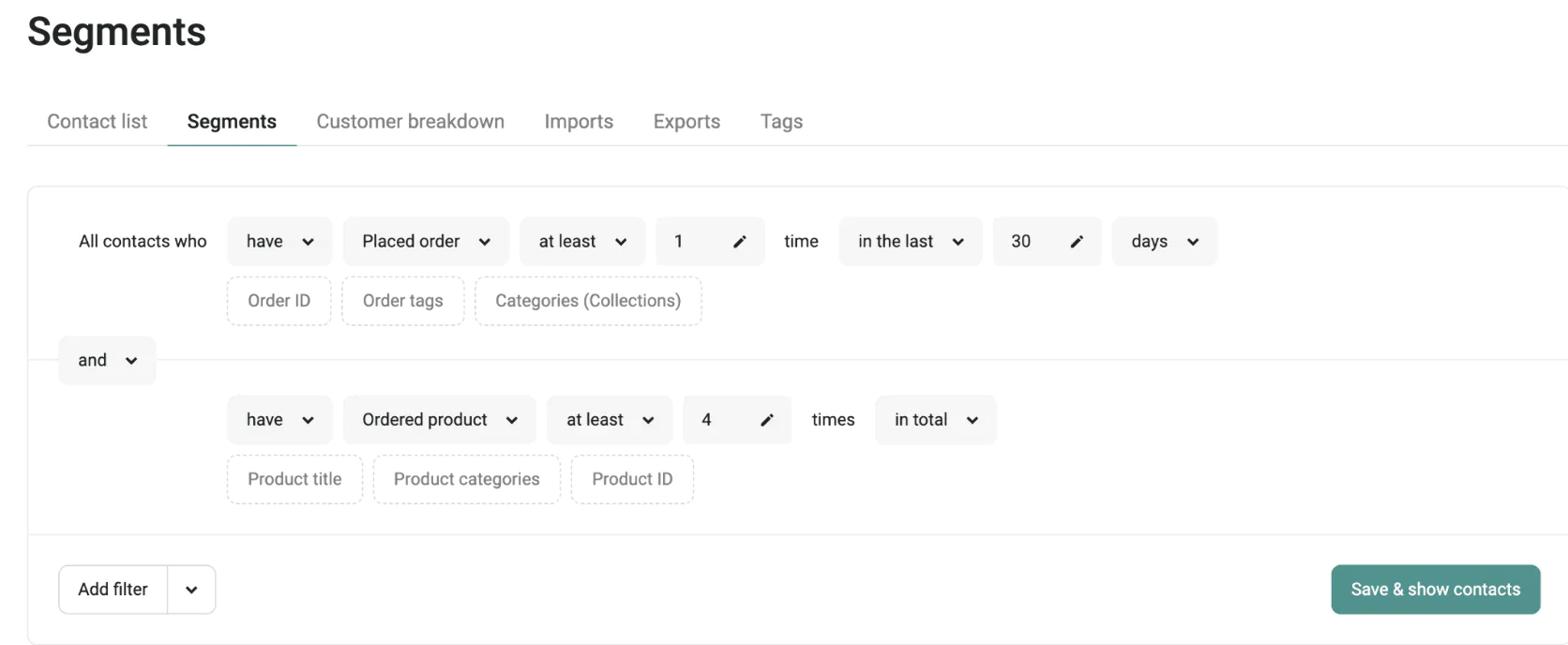
Omnisend’s segment builder
Strengths and weaknesses
Omnisend’s key strength is value for money. The platform offers a lot of functionality for a relatively low price. The free plan is quite usable—it allows up to 250 contacts and 500 emails/month with all features enabled, so small stores can actually run on free until they grow. Even the paid plans ($16/month and up) include all channels (email/SMS/push) with no feature gating, which contrasts with some competitors that put certain features only in higher tiers.
Users often praise how quickly they can set up effective automations in Omnisend. The interface is designed for marketers, not developers, so setting up a cart abandonment series or a welcome drip is very straightforward—essentially toggle it on and it’s live.

Omnisend’s email templates
Another strength is its 24/7 support for all users, including those on free plans. This is a big plus for merchants who might need help at odd hours.
Omnisend also continuously adds nice-to-have features (like their recent rollout of push notifications and the product review widget) that give small businesses a more all-in-one toolkit.
On the flip side, Omnisend is not as advanced as some higher-end tools. Its segmentation is good but not as deep as Klaviyo’s—you have basic logic and can target by shopping behavior, but it might lack some multi-condition refinement.
Also, while Omnisend integrates with eCommerce platforms well, its ecosystem of integrations is smaller (it may not have built-in connectors to obscure apps your store uses).
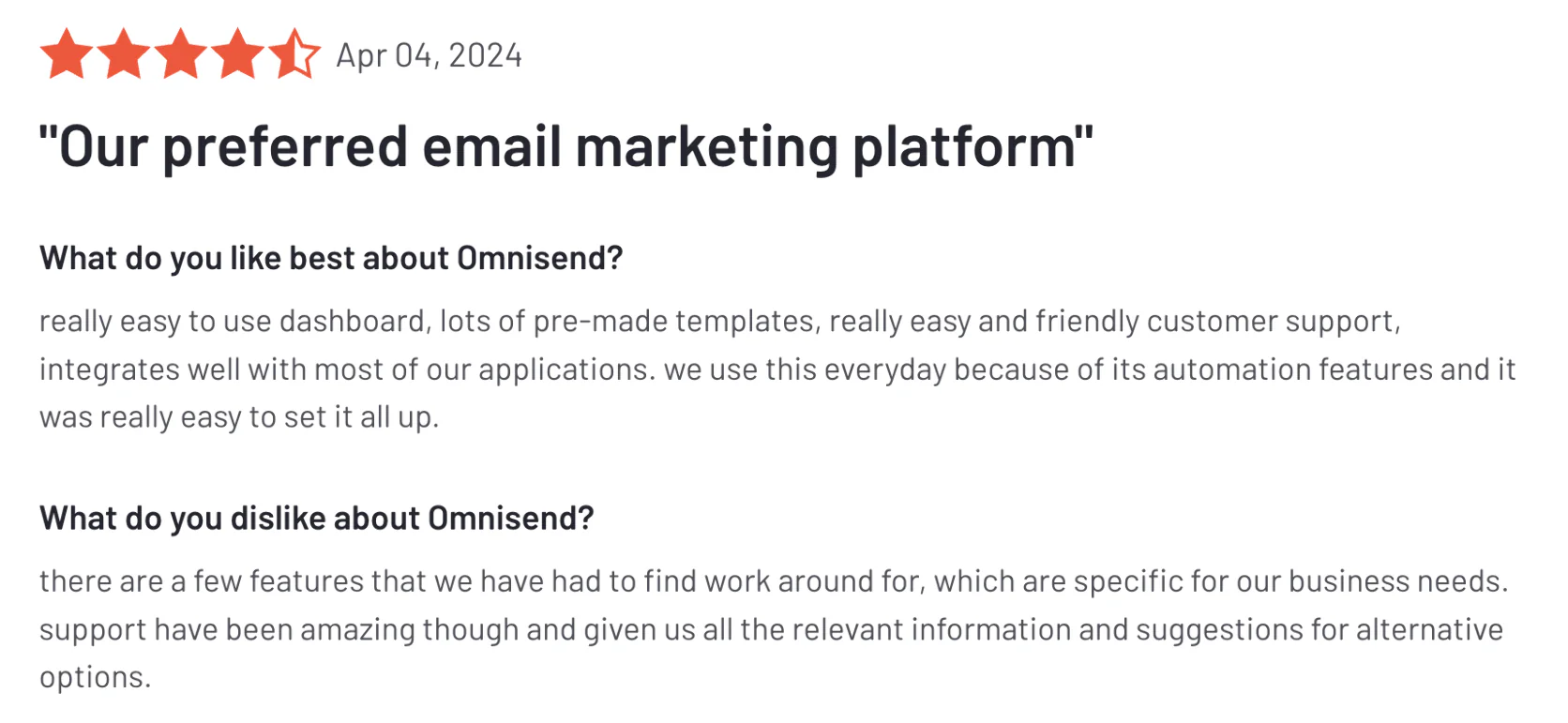
Some users note that the email template designer, while drag-and-drop, isn’t as flexible in design as they’d like—it covers most needs but can feel limiting if you want highly unique layouts. Scalability could be a concern: very large enterprises would probably find Omnisend too basic in analytics and maybe insufficient in deliverability fine-tuning (though it works great for the majority of SMBs).
Another weakness is that the SMS feature is region-limited on lower plans (the standard plan includes only a small number of SMS to certain countries, though you can buy more). And while the platform is easy to use, that sometimes means less customization; for instance, the workflows are somewhat templated, so you can’t create extremely complex branching logic like you might in an enterprise automation tool.
In summary, Omnisend’s weaknesses are mainly at the high end—for most small to mid businesses, it capably covers the bases, but it’s not intended for highly bespoke enterprise use cases.
Compared to Listrak
Omnisend and Listrak target different market segments in many ways. Listrak is an enterprise-grade platform, whereas Omnisend explicitly appeals to smaller brands and those who need simplicity. If you’re a current Listrak user, moving to Omnisend would likely save a lot of money but also might require giving up some advanced capabilities.
For example, Listrak’s predictive analytics or its individualized product recommendations might be more sophisticated than Omnisend’s out-of-the-box features. Listrak also offers more consulting services (for a fee), whereas Omnisend is more do-it-yourself (with support available, but not a dedicated strategist by default).
However, many users feel that they don’t fully utilize Listrak’s advanced bells and whistles—and if that’s the case, they’re essentially overpaying. Omnisend covers the core use cases very well: emailing customers, texting them offers, automating key lifecycle messages. In fact, Omnisend can be a breath of fresh air for someone overwhelmed by Listrak’s complexity.
The time-to-launch is typically faster on Omnisend, since everything is template-driven and straightforward. Also, Listrak’s pricing being opaque and contract-based can be frustrating; with Omnisend you can literally start for free and know exactly how costs scale as you add contacts or need more sends.
It’s that transparency and low barrier that make Omnisend attractive to those who feel Listrak is too heavy (or too heavy-handed in sales).
One thing to consider is deliverability and volume—Listrak, being enterprise, is built to handle very large send volumes and has deliverability teams and tools suited for that. Omnisend handles deliverability well for its client base (and gives guidance), but a massive retailer might prefer the custom IP pools and advanced deliverability consulting Listrak provides.
In essence, switching from Listrak to Omnisend makes sense for a mid-sized brand that found Listrak overly complex/expensive for what they actually need. You trade some high-end features for simplicity, agility, and cost-effectiveness.
Many merchants report they get 80% of the results at a fraction of the cost with Omnisend, which is a compelling argument if you’re not using Listrak’s full power.
Compared to Maestra
Omnisend vs Maestra is somewhat a comparison of good vs better/best, in terms of capabilities. Maestra offers everything Omnisend does, and then quite a bit more. For instance, Omnisend’s segmentation might let you target customers who bought item X but not Y; Maestra’s segmentation (with its real-time CDP) could let you target those who browsed certain categories in the last 5 minutes and have a loyalty tier of Gold, triggering a completely personalized message—a level of precision Omnisend can’t reach.
Maestra also includes on-site personalization and loyalty programs, which Omnisend doesn’t. So if a brand needs those extra functions, Omnisend would require additional apps, whereas Maestra has them built-in.
That said, Omnisend’s advantage is cost. It’s much cheaper—Maestra is aimed at a higher tier of clients with a larger budget.
Omnisend is very much “plug and play” for everyday marketing needs, whereas Maestra is for crafting highly bespoke customer journeys.
Another point is support: Omnisend has responsive support, but Maestra provides a dedicated success manager as part of the package. CSM handles it all—configuring flows and segments, conducting A/B tests, and even creating flow content that feels like it came straight from you.
Omnisend is like a Honda that reliably gets you from A to B with minimal fuss, whereas Maestra is a high-end vehicle with more horsepower and luxury features. Both aim for ease of use, but Maestra is a more expansive platform for when marketing needs become more advanced.
Tool #4: Postscript
Best for: E-commerce brands (especially on Shopify) that want a specialized SMS marketing solution to complement their email platform.
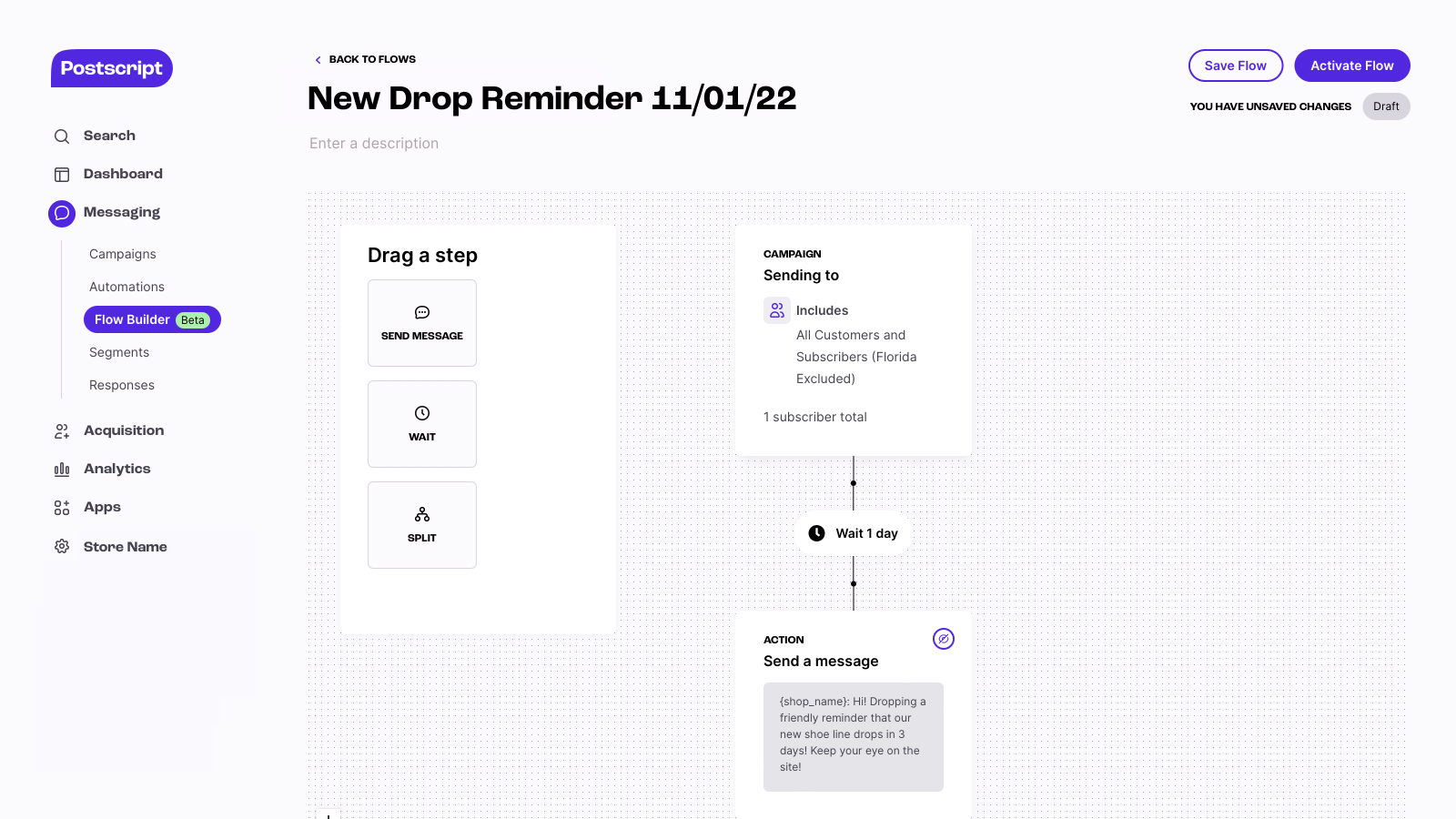
Postscript’s flow builder
Postscript is a popular SMS/MMS marketing platform built with Shopify stores in mind. This tool focuses entirely on text-message based campaigns and automations, carving out a niche for itself as an expert in the SMS channel.
For brands that already have email covered (maybe by Klaviyo, Omnisend, etc.) but need a robust way to do text messaging—or for those who find Listrak’s SMS capabilities lacking—Postscript is a top contender.
Key Features:
- SMS & MMS campaigns: easily create promotional SMS campaigns or send rich MMS messages with images/GIFs. You can do one-off blasts or segment-based sends (e.g., a sale announcement to VIP customers only).
- Automated flows: set up text message automations for welcome series (after someone opts in via a keyword or form), abandoned cart reminders via SMS, shipping updates, win-back campaigns, etc. These flows are as crucial to SMS strategy as email ones are to email marketing.
- Two-way conversation: Postscript supports two-way messaging, meaning customers can reply to your texts and you can respond. Many brands use this for conversational commerce or customer support via text. The platform provides an inbox to manage replies.
- List growth tools: built-in tools like keyword opt-in (e.g., “Text JOIN to 12345 for 10% off”), QR codes for signup, and pop-up forms that capture phone numbers. It integrates with Shopify so you can also collect numbers at checkout.
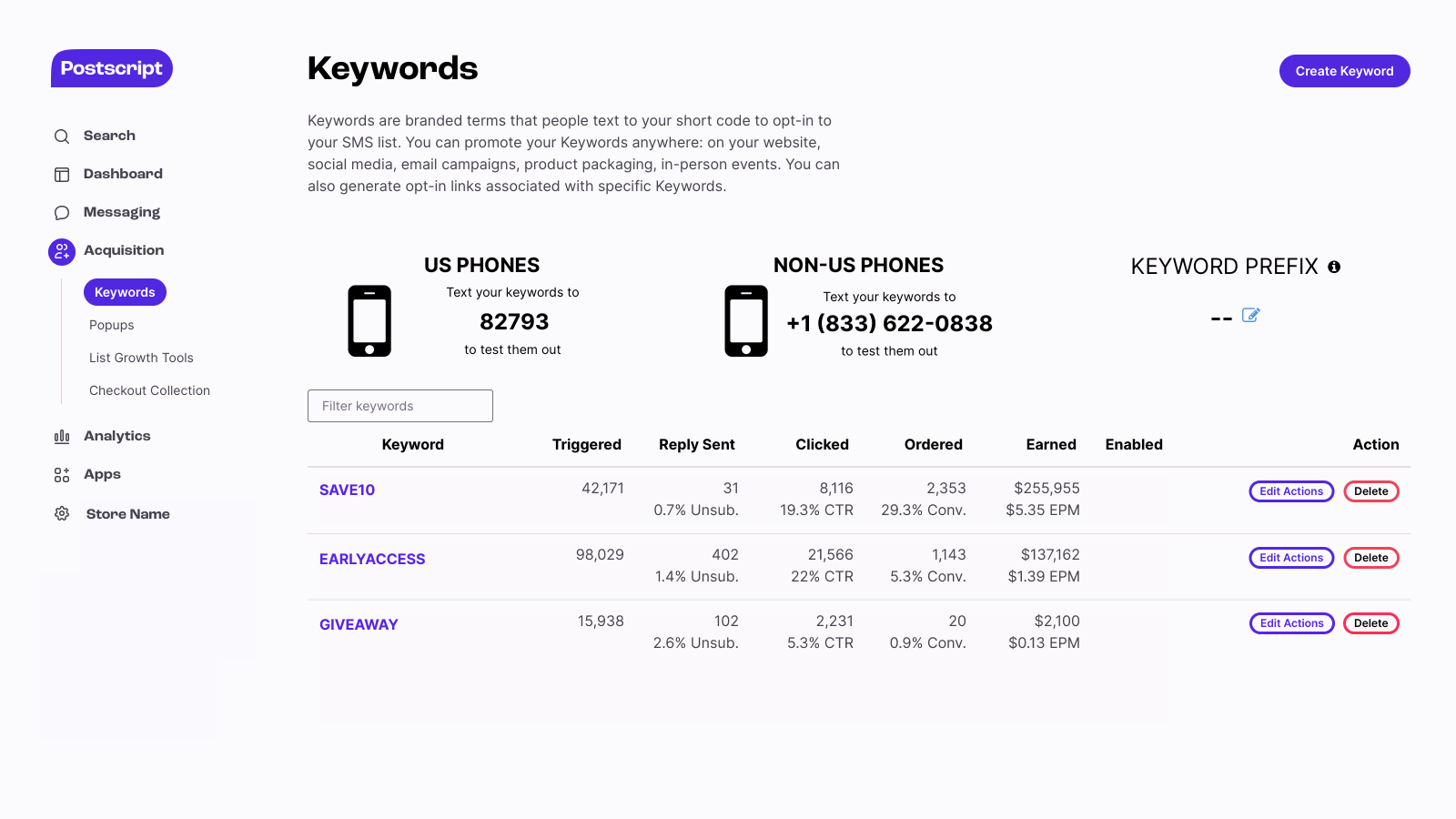
Postscript’s keyword opt-in
- Compliance management: SMS has strict legal requirements. Postscript helps by automatically handling things like opt-out language (“Reply STOP to unsubscribe”), quiet hours (not texting in the middle of the night), and providing TCPA/CTIA compliance guidelines.
- Analytics & ROI tracking: Track revenue attributed to SMS campaigns, click-through rates on texts, subscriber growth, and even responses. It can integrate with Google Analytics and other tools to see cross-channel impact.
- Integration ecosystem: Postscript integrates with other apps—for example, it can work alongside Klaviyo (syncing segments), or integrate with helpdesks like Gorgias to create support tickets from text replies.
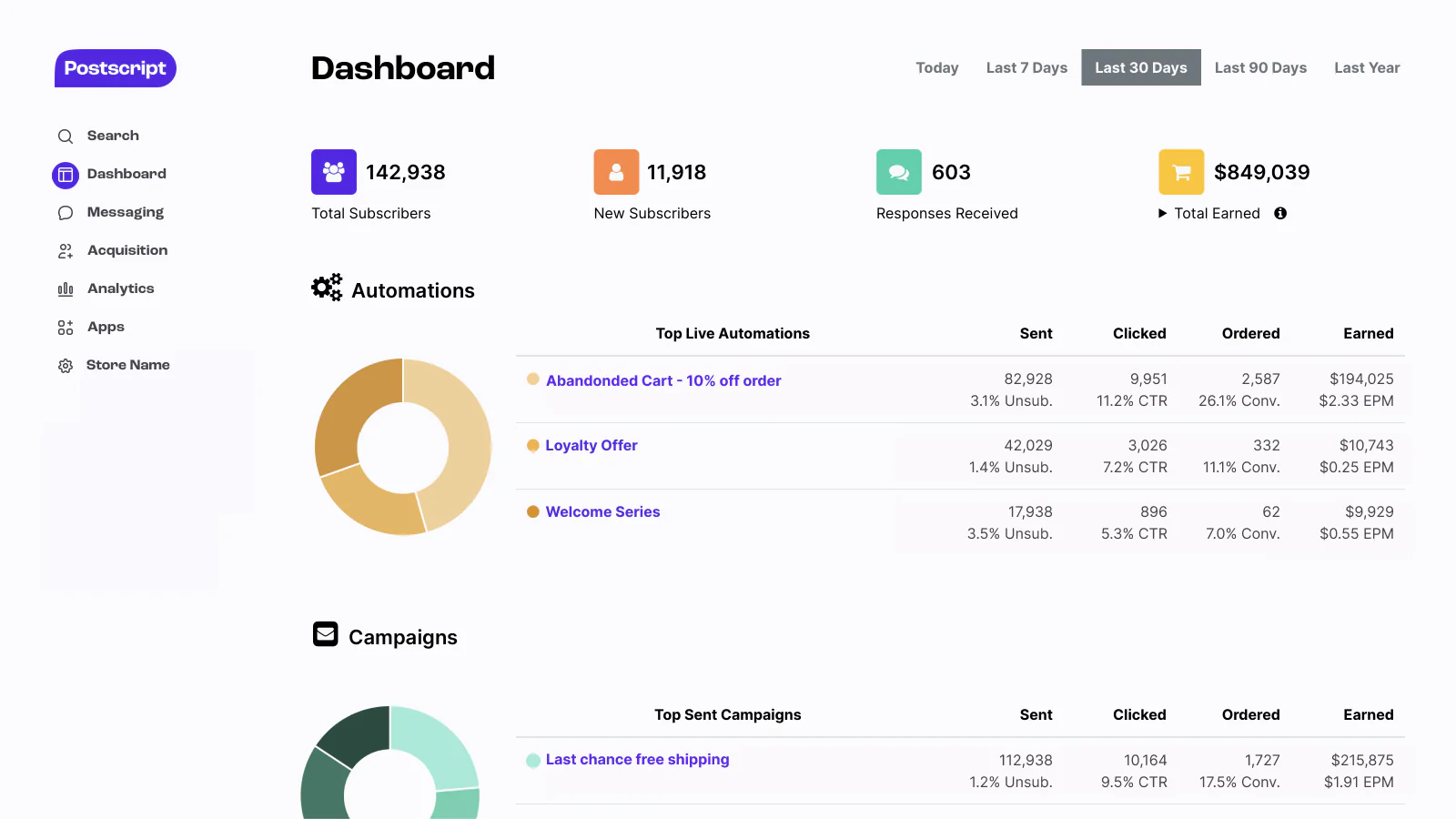
Postscript’s dashboard
Strengths and weaknesses
The strength of Postscript lies in its laser focus on SMS. Because it’s not juggling email or other channels, the team has built out features that really cater to texting. Users appreciate the conversational aspects—unlike some email-first platforms that bolt on SMS, Postscript was designed from the ground up to handle back-and-forth text messaging, which is how consumers often engage with brands (asking product questions, etc.).
Its Shopify integration is superb, meaning you can use Shopify data (like items in cart, last order value) to segment and trigger SMS messages easily.
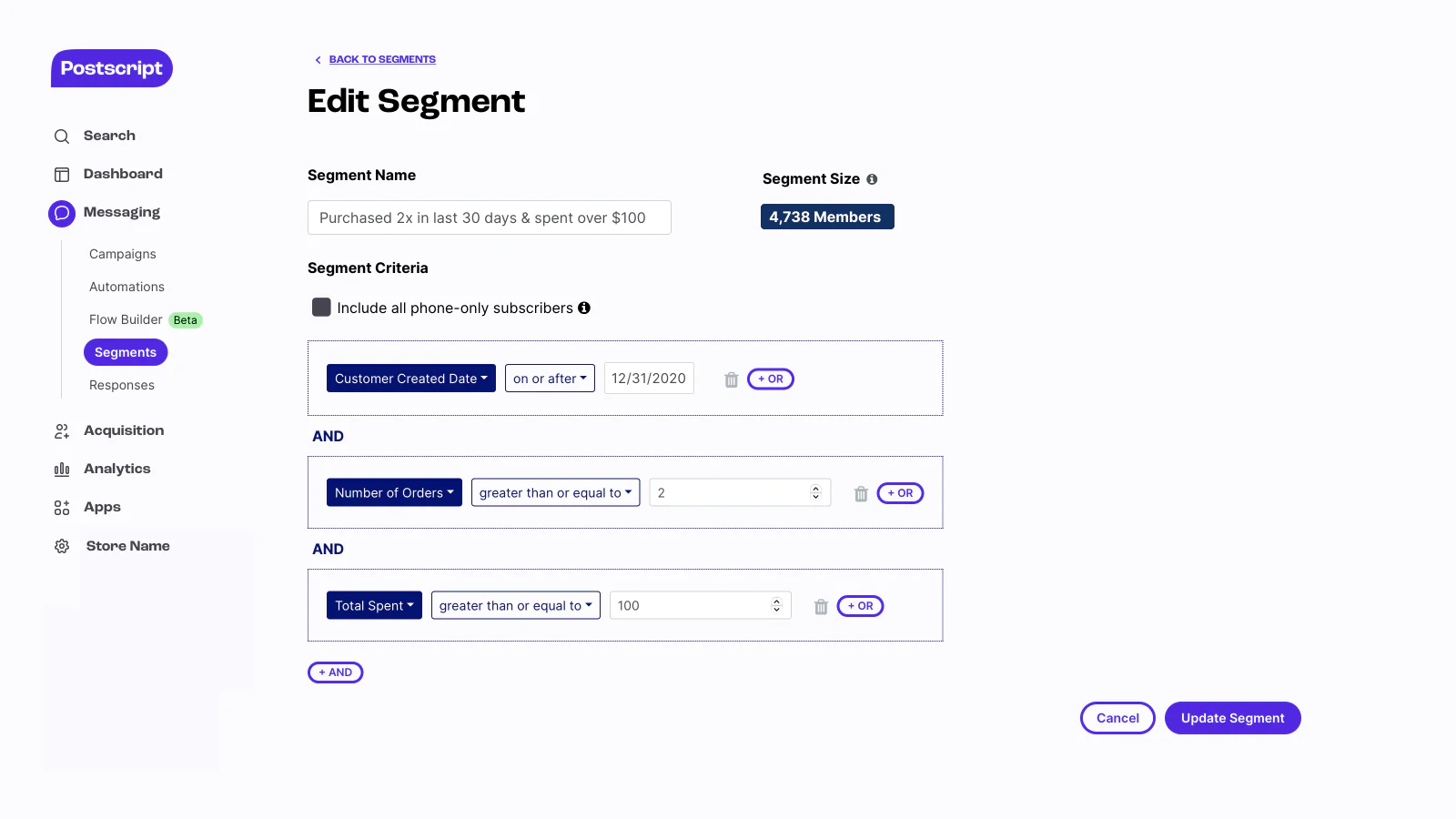
Building a segment in Postscript
The platform also scales well; it handles messaging for brands with massive SMS lists, with reliable deliverability even during peak times (like Black Friday).
Another strength is Postscript’s flexible pricing—there’s a free-to-start plan where you only pay for usage (messages sent), which is great for testing the waters. As you scale, you can move to higher plans that offer better message rates or additional services, but you’re never paying for more than you use, essentially.
On the weakness side, since Postscript is SMS-only, you will still need a separate solution for email. Some marketers don’t love switching between tools—they might prefer having one dashboard for all communications. Additionally, while Postscript’s analytics are solid for SMS metrics, they won’t give you a full picture of customer behavior across channels (again, because it’s not an all-in-one). You’d need to consolidate reporting elsewhere.
Postscript also faces competition from newcomers including Attentive and others; some of those competitors have introduced AI features (like AI-generated text suggestions or automated response bots) that Postscript is only beginning to explore.
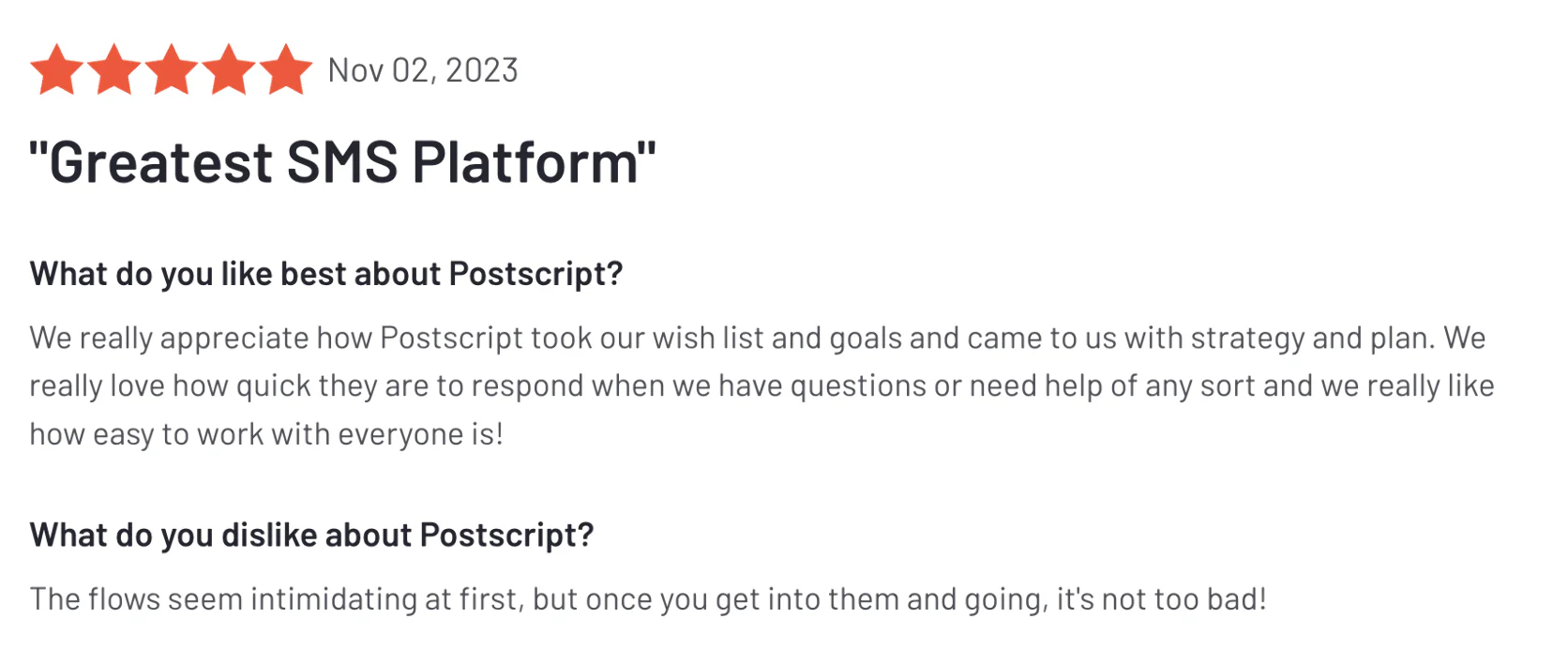
Another potential drawback is cost at large scale; SMS is inherently costly per message, and while Postscript’s rates are competitive, sending tens of thousands of texts can add up quickly—but that’s true of any SMS platform.
Finally, one could argue that if a brand’s SMS program becomes very advanced, they might crave even more sophisticated journey-building or data science-driven targeting than Postscript provides (at which point, a more integrated solution or a custom approach might be considered).
In summary, Postscript’s weaknesses are mostly the flip side of its focus: it does SMS very well but doesn’t do email or web, so it’s one piece of the puzzle. And it’s a fairly straightforward platform; super advanced marketers might hit its limits in terms of customization.
Compared to Listrak
If you’re considering Postscript as an alternative to Listrak’s SMS capabilities, the key question is whether you want a best-of-breed SMS tool versus an integrated suite. Listrak offers SMS as part of its omnichannel toolkit (they have a feature called Journey Hub that encompasses SMS, email, etc.), but some users find it doesn’t specialize in SMS enough. For example, Listrak’s two-way SMS is available but perhaps not as refined in interface as Postscript’s dedicated SMS inbox. Also, Listrak’s opt-in tools are more limited—whereas Postscript provides a lot of creative ways to build your SMS list (keywords, pop-ups, etc.).
Listrak has the advantage of unified data—your email and SMS live together. With Postscript, you’ll need to ensure it’s integrated with your email/CRM (which it can do, but it’s an extra step) to avoid messaging conflicts or to coordinate campaigns.
On pricing, Listrak might bundle SMS in your contract (but often with an added cost per message or contact). Postscript is transparent usage-based pricing, which many find more economical.
So, if Listrak’s support or features for SMS have been lacking for you, using Postscript could supercharge that channel. Many brands use Listrak for email and plug in Postscript for SMS to get the best of both. The downside is having two platforms, but the upside is expert-level SMS performance.
In short, choose Postscript over Listrak’s native SMS if you want specialization and possibly a more budget-friendly, hands-on approach to text marketing. If you prefer everything in one place and don’t need cutting-edge SMS features, you might stick with Listrak for convenience.
Compared to Maestra
Comparing Postscript to Maestra is a bit of apples vs. oranges because Maestra is an all-in-one platform. If a brand is using Maestra, they wouldn’t need Postscript, since Maestra has its own SMS capabilities fully integrated. But consider a brand evaluating options: why pick Postscript + another email tool vs. using Maestra for both?
Maestra’s SMS is part of a larger picture. With Maestra, your SMS, email, push, etc., all draw from the same customer data platform. So you can orchestrate cross-channel experiences more easily. Postscript would require coordination—say a customer gets an email and an SMS, those triggers need to be managed between your email platform and Postscript. Maestra can ensure, for example, if an email goes unopened for 2 days, then send an SMS, without you needing two systems to talk to each other—it’s all one flow.
Also, Maestra’s approach to segmentation could make your SMS more targeted (because it can consider cross-channel behaviors).
If a brand is smaller and not ready for Maestra, they might use Postscript + something like Klaviyo. As they grow, consolidating into Maestra could simplify operations. Essentially, Postscript + other tools = more modular, possibly cheaper for small scale, but more fragmented, whereas Maestra = unified and powerful.
There isn’t a scenario where you’d use Maestra and Postscript together (since that’s redundant); it’s a choice. Postscript is excellent for SMS alone. Maestra is excellent for SMS and everything else together. For a multi-channel strategy looking to minimize complexity, Maestra wins. For a lean “just need great SMS” approach, Postscript is a winner.
Tool #5: Attentive
Best for: Enterprise and high-growth brands that prioritize SMS marketing as a key channel and want a high level of hands-on support and AI-driven innovation in that space.
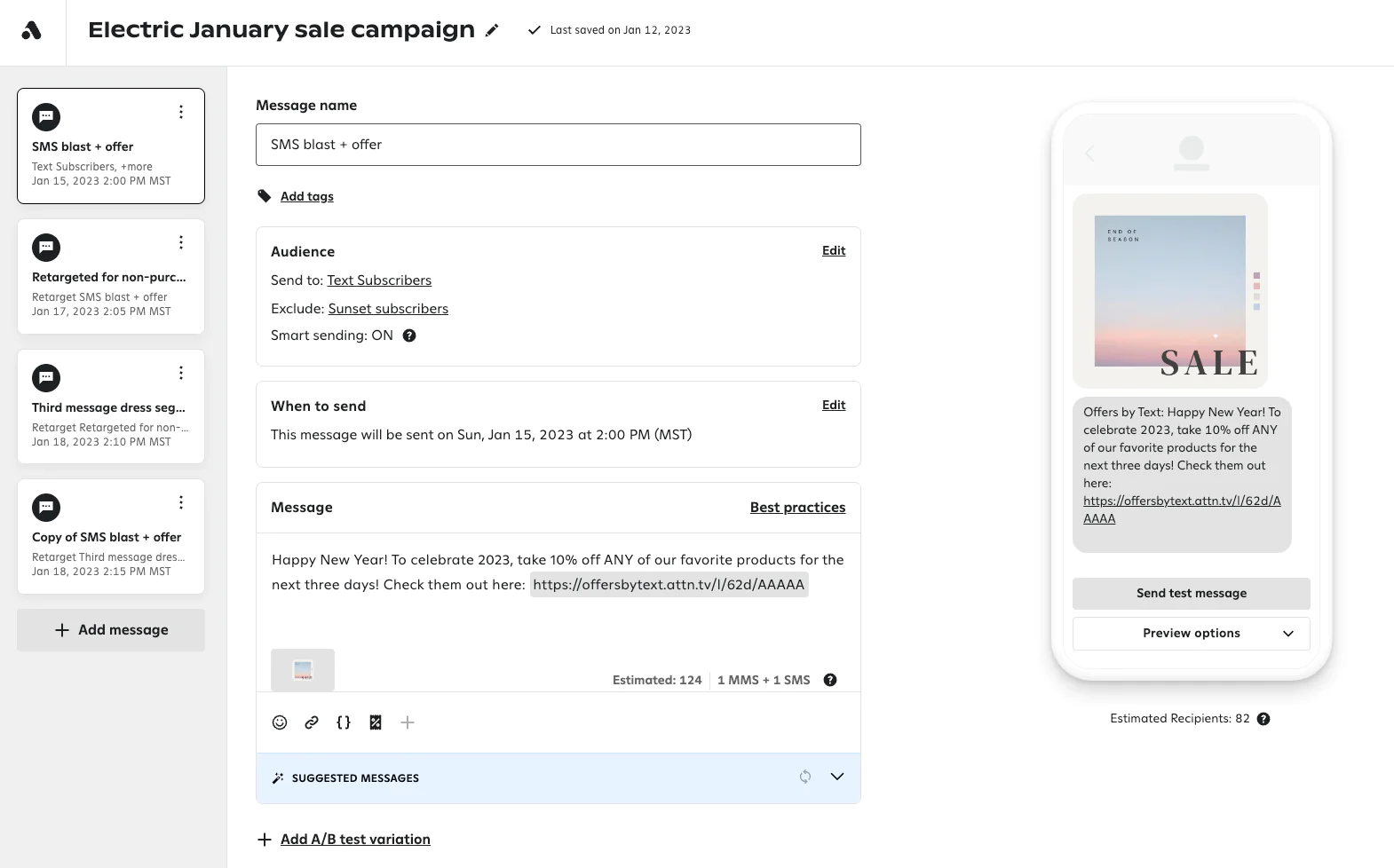
Attentive‘s Campaign Composer
Attentive has made a name for itself as a leader in SMS marketing, especially after 2020 when SMS as a channel exploded in retail/eCommerce. They position themselves as an “SMS-first” marketing platform with AI power, and they’ve since expanded to include email in their offering as well. Attentive is often mentioned in the same breath as Klaviyo, but whereas Klaviyo started with email, Attentive started with SMS. Many large brands (from CB2 to Urban Outfitters) have used Attentive to drive their text message strategy.
If Listrak represents the old guard of email-centric suites, Attentive is like the new kid on the block that’s really good at texting millennials and Gen Z on their phones—and doing it at scale.
Key Features:
- Advanced SMS Campaigns & Journeys: You can set up targeted text campaigns based on user behavior, with segmentation by purchase history, browsing events, etc. Journeys (automations) include welcome series, cart abandonment, browse abandonment texts, post-purchase follow-ups—all optimized for mobile engagement.
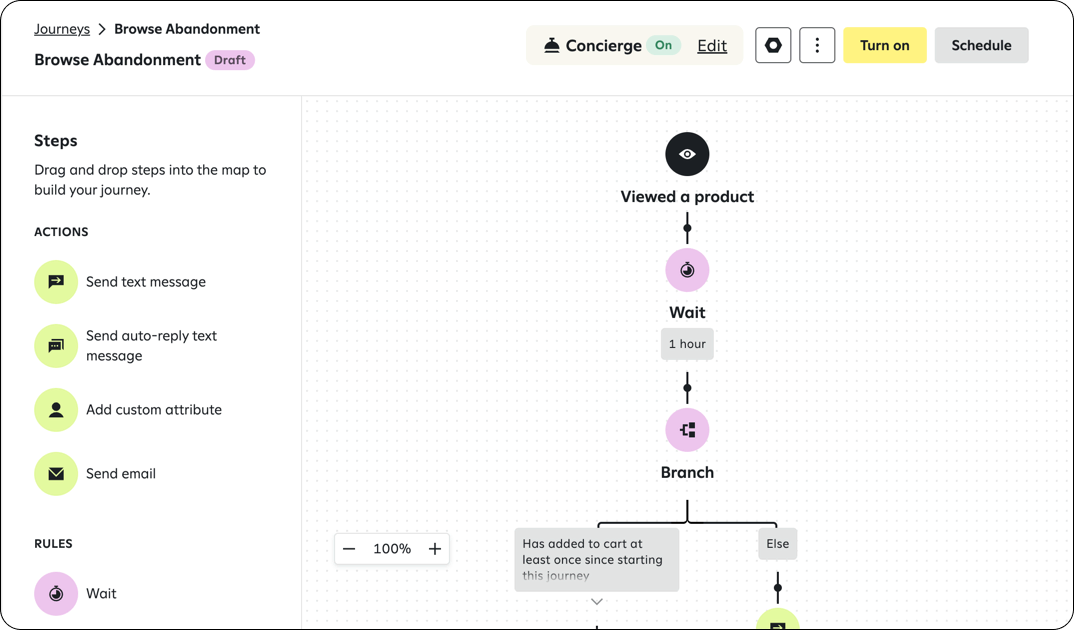
Attentive‘s journey builder
- MMS and Rich Media: Attentive supports rich media messaging and even interactive texts. For instance, you can send a quiz via SMS where users reply with answers, or dynamic coupon codes unique to each recipient.
- AI-powered optimization: Attentive has been heavily investing in AI. They offer an “Attentive AI” that can suggest the best send times, craft message content (or subject lines for email) using algorithms, and even automate replies for common customer responses via their “Concierge” feature.
- Sign-up units & growth tools: Attentive provides a suite of mobile-optimized sign-up forms, banners, and even text-to-join tools. Notably, they often use a “two-tap” sign-up for mobile web: a user taps a banner, which opens their SMS app with a prewritten opt-in text—very smooth UX for capturing subscribers.
- Personalization and data: Their platform, Attentive Signal, helps identify website visitors and tie them to SMS or email identities to personalize messages. They also enrich data to personalize texts (like using local store info, weather, etc., in messages, for some clients).
- Email marketing: As of 2024, Attentive offers email alongside SMS in a unified platform. While newer than their SMS, it means you can manage email campaigns and automations through Attentive’s dashboard, using the same segmentation and AI features across both channels.
- White-glove support and strategy: Attentive is known for its hands-on approach. They typically assign a dedicated client strategy team or manager to larger clients, assisting with campaign ideas, compliance, and performance reviews. Essentially, they act like an extension of your marketing team for texting, ensuring you maximize results (this is often cited as a differentiator in enterprise SMS).
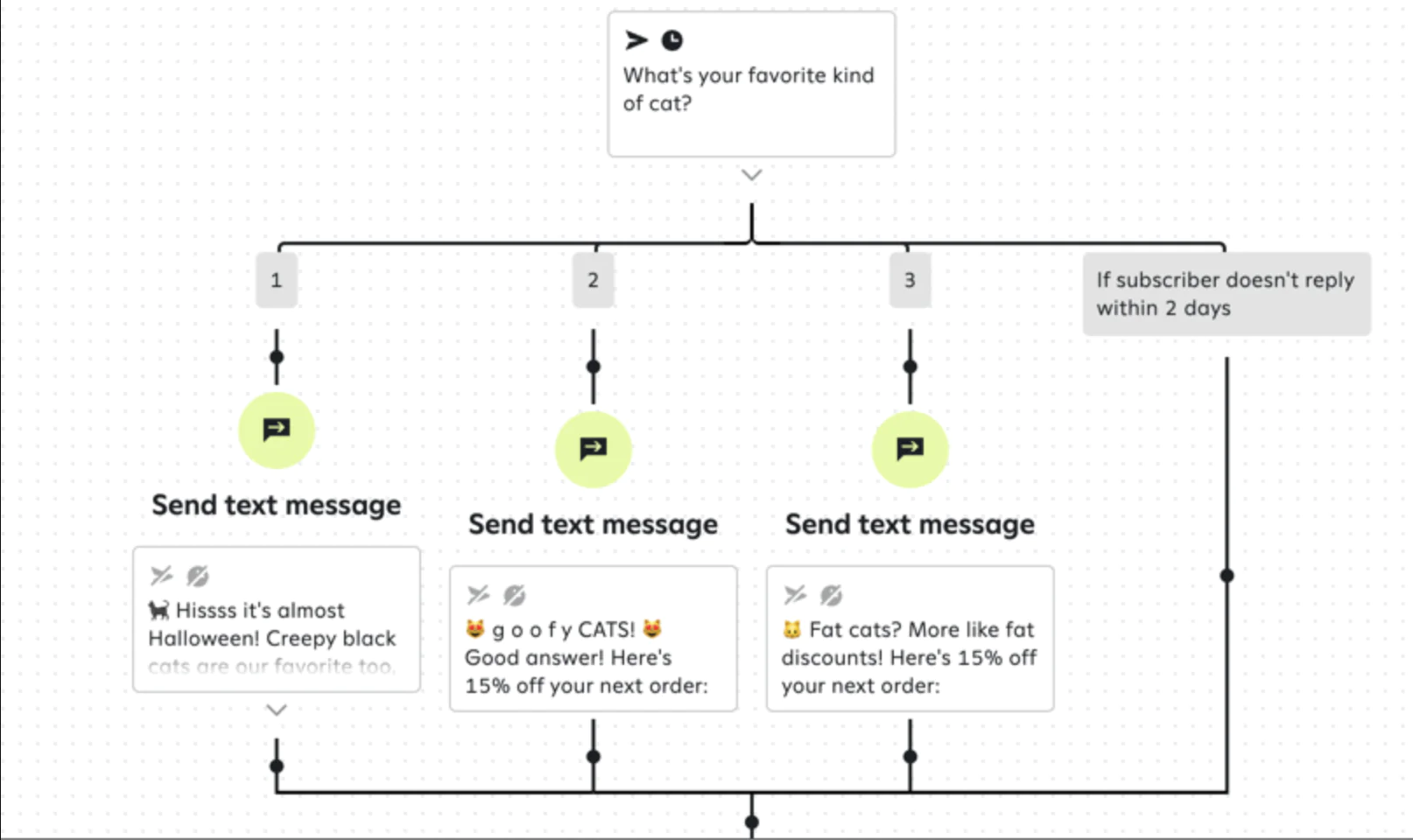
Two-way messaging in Attentive
Strengths and weaknesses
Attentive’s strengths stem from being a specialist with scale. They have some of the most sophisticated SMS capabilities on the market. For example, their platform can handle massive send volumes with very fast throughput (important when you’re texting tens of thousands of people about a flash sale). Brands love features like attentive’s automation of replies—their “Concierge” AI can automatically reply to common questions like “What’s my order status?” by integrating with your data, which offloads work from your support team.
Another big strength is customer support and guidance: Attentive consistently gets high marks for their account support. They proactively suggest campaign tweaks, share best practices, and ensure you’re following compliance. This is a boon for companies new to SMS or without dedicated SMS experts on staff.
Innovation is another strength—Attentive has been quick to roll out new features (like integrating with social to capture subscribers, or the use of QR codes in physical stores to get SMS opt-ins, etc.). They also are at the forefront of compliance advocacy—sitting on industry boards to shape texting regulations, which means their clients are always in the loop on the latest rules. Finally, since Attentive now has email, a brand could use it for both channels and have decent synergy (though their email product is still growing).
On the weak side, the most commonly cited issue is cost. Attentive tends to be one of the pricier options—they often work with larger clients who can spend a minimum amount. They typically charge a platform fee plus messaging fees; for instance, a base fee around a few hundred dollars a month plus usage. Smaller businesses might find it out of reach or not as cost-effective, which is why Attentive’s clientele skews mid-market and up.
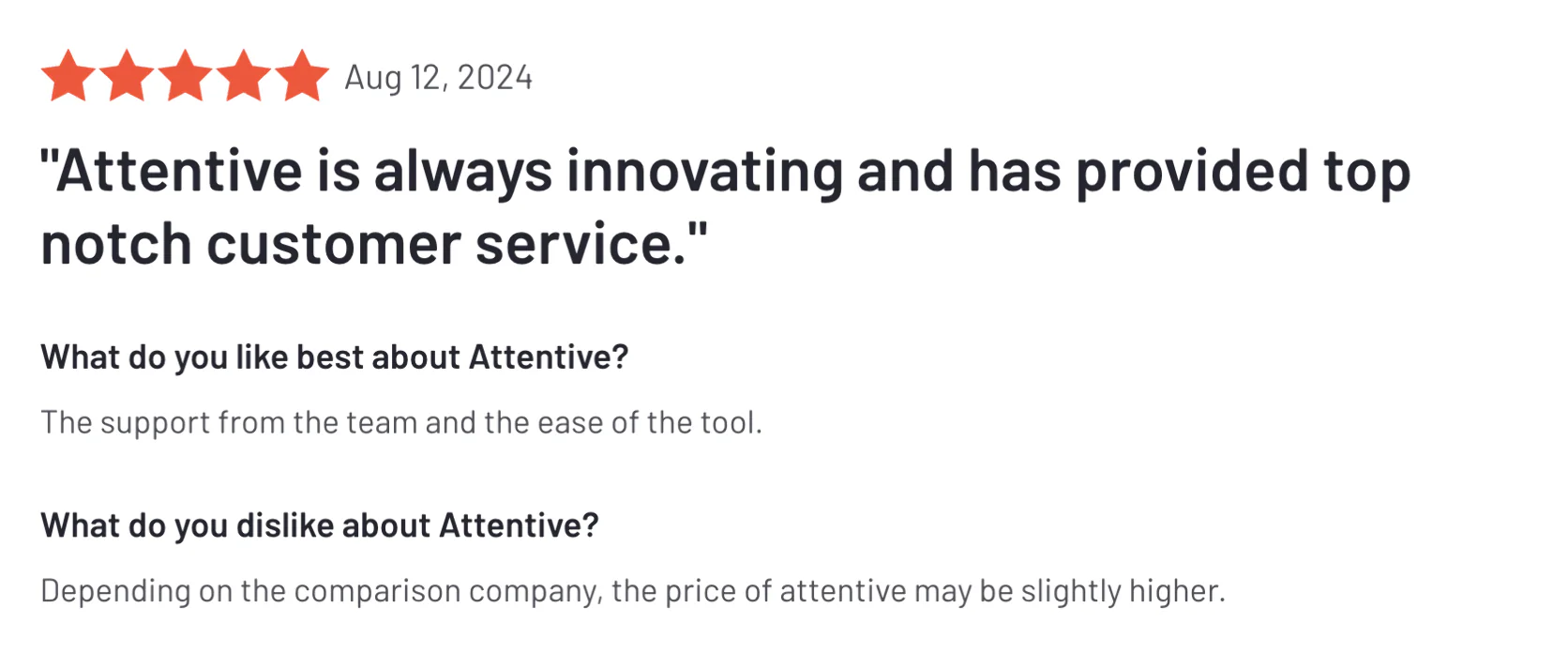
Another weakness is that being SMS-centric means if you don’t heavily invest in the SMS channel, you’re not getting the ROI—Attentive makes sense if you plan to make SMS a top revenue driver; otherwise it’s overkill. Additionally, while they have added email, their email tooling isn’t as mature as dedicated email platforms (at least as of 2025). So some users feel it’s not yet on par with the Klaviyos of the world in that aspect. Using Attentive just for email would be odd—you use Attentive for SMS primarily.
Lastly, the platform can be a bit heavy—there’s a lot of features and it may feel complex if you’re a one-person marketing team. It’s optimized for those who want to squeeze every drop out of SMS with fine-tuning and strategy, which is fantastic when leveraged, but not every brand has the bandwidth to do so.
In short, Attentive’s weaknesses are mostly about cost and scope—it might be too much tool (and budget) for smaller needs, and its email solution, while convenient, isn’t their core strength yet.
Compared to Listrak
For brands evaluating Listrak vs Attentive, it often comes down to where you see the future of your marketing focus. If you believe that SMS is the priority channel to engage your customers (for instance, if you see significantly higher conversion rates from texts than emails), then Attentive offers a level of specialization that Listrak doesn’t.
Listrak’s heritage is email; it added SMS to keep up with the market. Attentive was built around SMS from day one, so things like two-way messaging, rich media, and SMS-specific analytics are more advanced. Also, Attentive provides more guidance on text strategy—Listrak might give you a toolset, but Attentive will give you a toolset plus a de-facto consultant to help use it. That can be invaluable if your team is not experienced in SMS; they basically ensure you’re not just blasting, but truly conversing and personalizing via text.
On the other hand, Listrak covers more channels natively (email, SMS, push, even some on-site and identity resolution features). If you want a one-stop shop and don’t mind that some features (like its SMS) are a bit less cutting-edge, Listrak is an all-in-one. Attentive now does email, but it’s really SMS-centric. Many brands actually use Attentive for SMS and another platform for email—which is a two-vendor solution akin to using Postscript for SMS alongside something else. So choosing Attentive over Listrak might mean you’re committing to a dual-platform approach.
Integration is key here: if you did Listrak, data and messaging are under one roof; with Attentive plus another email tool, you need integration to sync segments and avoid overlapping messaging. Attentive has integrations for popular email platforms to help with that, but it’s a consideration.
From a pricing perspective, both Listrak and Attentive are premium. Listrak might come in a package deal, whereas Attentive’s pricing will be more usage-based. Some retailers have found Attentive to drive so much SMS revenue that the cost is justified or even cheaper on an ROI basis (especially if Listrak was underutilized but expensive).
If Listrak’s support or innovation pace frustrated you, Attentive’s energetic approach might be refreshing—their focus on AI and new capabilities could give you an edge in marketing. Meanwhile, one must consider technical integration: if your eComm stack is already integrated with Listrak and switching to Attentive means redoing workflows and data feeds, that’s an effort (though Attentive’s team usually assists).
In essence, choose Attentive over Listrak if SMS is your gold mine and you want the best partner to mine it—and you’re willing to handle email separately (or try Attentive’s email in tandem). Choose Listrak if you prefer one platform for a decent (if not best-in-class) execution across channels, or if email remains your primary channel and SMS is secondary.
A lot of brands actually run Listrak vs Attentive pilots specifically to compare SMS performance. It’s not uncommon to hear that Attentive can boost SMS program results meaningfully thanks to their optimizations and strategy input. If that’s your scenario, Attentive becomes a very compelling alternative.
Compared to Maestra
Attentive vs Maestra is a comparison of a channel-specialist (Attentive) and an omnichannel generalist (Maestra)—albeit Maestra is a very advanced generalist. If a brand is looking at Maestra, they likely want one platform to manage everything: email, SMS, loyalty, site personalization, etc., with unified data.
Attentive would not fulfill that, since it’s primarily about messaging (SMS and some email). So, the decision here is about the breadth of needs. For a brand that already has complex loyalty programs, web personalization initiatives, and a desire to consolidate tools, Maestra offers a one-stop solution, which Attentive cannot match.
Maestra’s SMS capabilities, while maybe not carrying the Attentive brand name, are robust and integrated with other channels—meaning you can craft cross-channel experiences more seamlessly. For instance, Maestra can coordinate an email and SMS so they don’t step on each other’s toes (or can A/B decide which channel to use for a given customer based on preference). Attentive doing that would require an external decision engine or a heavy integration with your email tool.
However, Attentive might outshine Maestra in SMS-specific optimizations and support. For example, Attentive’s AI reply bots or their massive library of “Texts We Love” (examples from other brands) provide very granular SMS expertise that Maestra, being broader, may not focus on as much.
If a brand’s main pain point is “we need to drastically improve our SMS program” and they’re otherwise okay with their email/loyalty tools, Attentive could be the more targeted fix. But if the pain point is “we have too many siloed tools and inconsistent data, and our marketing needs a unified upgrade,” Maestra addresses that holistically (and still gives you a strong SMS program in the process).
One can also consider long-term strategy: Maestra is built to be a central hub (including offering a CDP, etc.), which could future-proof a marketing stack as channels evolve. Attentive is expanding (adding email, presumably maybe more in future), but right now it’s narrower.
In terms of cost, Attentive might charge, say, $5k/month for SMS on a large list plus maybe some for email; Maestra might be $2k–5k for everything. So cost could actually favor Maestra when you add up apples-to-apples (hard to directly compare, but Maestra including all channels can sometimes be more economical than piecing together an Attentive + others of similar caliber).
In summary, Maestra is the choice for an integrated approach—you get very good SMS capabilities plus everything else in one platform, which ensures consistency and real-time coordination. Attentive is the choice if you believe a dedicated SMS powerhouse will drive better results and you’re okay managing other parts of marketing elsewhere.
Tool #6: SMSBump (Yotpo SMS & MMS)
Best for: Shopify store owners (and other eCom merchants) who want a straightforward, pay-as-you-go SMS marketing solution—particularly those already using other Yotpo products (reviews, loyalty).

Creating an SMS campaign in SMSBump (Yotpo SMS & MMS)
SMSBump is an SMS marketing app that became well-known in the Shopify ecosystem and was later acquired by Yotpo (a company famous for reviews and loyalty apps). It’s now often referred to as Yotpo SMS & MMS. This tool is popular for merchants who need to get an SMS program off the ground quickly without big upfront costs. It’s feature-rich enough for robust texting campaigns but is also designed to be very accessible (both in ease and price) to small and mid-sized businesses.
If you use Yotpo for product reviews or loyalty, SMSBump integrates nicely, but it can also stand alone.
Key Features:
- SMS & MMS campaigns and automations: Like others, you can send bulk SMS or schedule campaigns for sales, product launches, etc. Automation templates include cart abandonment texts, welcome messages after signup, shipping notifications, and customer win-back texts. These are easy to set up with toggle-on workflows.
- Personalization and segmentation: SMSBump allows inserting dynamic fields (customer name, coupon codes, last product viewed, etc.) into texts. You can segment your SMS list by things like location, customer tags, purchase history (if integrated with Shopify/Yotpo loyalty data), and send targeted messages.
- Compliance and easy opt-out: It automatically manages unsubscribe keywords and provides the necessary legal verbiage in messages where required. It supports double opt-in if you want to ensure high-quality subscribers.
- Growth tools: It offers a variety of ways to capture subscribers—a signup widget for your site, the ability to convert email subscribers to SMS by offering an incentive, integrations with Facebook to collect phone numbers via ads, etc. Also, since it’s part of Yotpo, it can tie in with Yotpo’s Loyalty to prompt customers to subscribe for points or with Yotpo’s Reviews to ask for a review via text.
- Analytics dashboard: You can monitor the performance of each SMS campaign or flow—seeing clicks, conversions, ROI. SMSBump also highlights ROI quite transparently, showing how much revenue each text brought in (provided you’re on Shopify or a platform where it can attribute sales).
- Integration with Yotpo suite and more: Apart from Yotpo’s own products, SMSBump integrates with Shopify (native app), and has APIs/Zapier to connect with other tools. It also connects with Shopify Flow for customized triggers if you use that for automation.
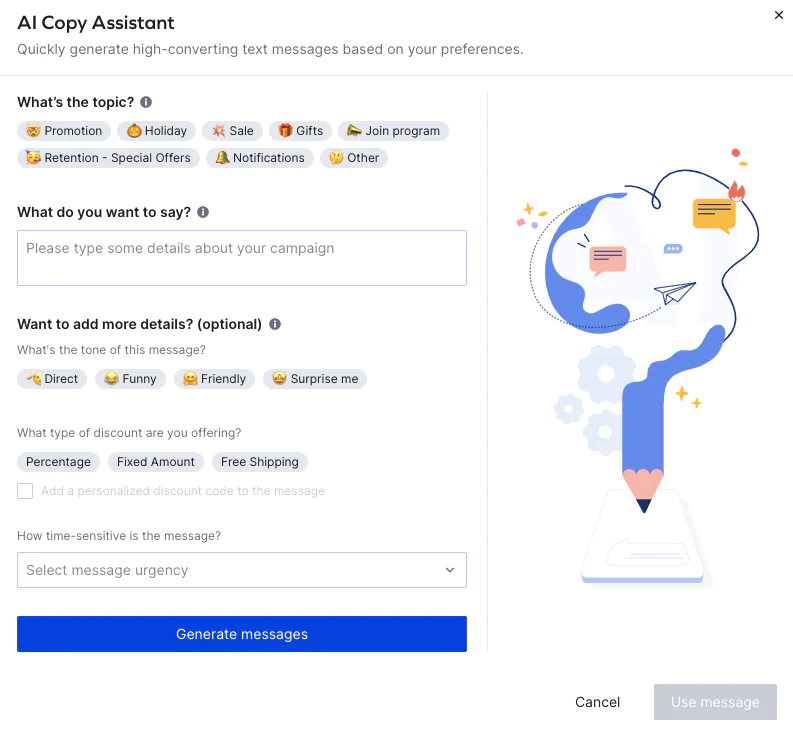
Yotpo’s AI Copy Assistant
Strengths and weaknesses
One big strength of SMSBump is its affordability and flexible pricing. It’s free to install and has no monthly fee on the basic plan—you literally pay per text sent (with a minimum spend of around $19-$25 a month). This means low risk to start; you’re not committing to a large contract. For many small businesses, this is ideal. Even the higher tiers (like $49 or $59/month plans) simply offer better SMS rates and some premium features, which is still very approachable.
Another strength is deep Shopify integration—the app feels like a native part of Shopify when you use it. It’s in the Shopify admin, making it convenient to manage.
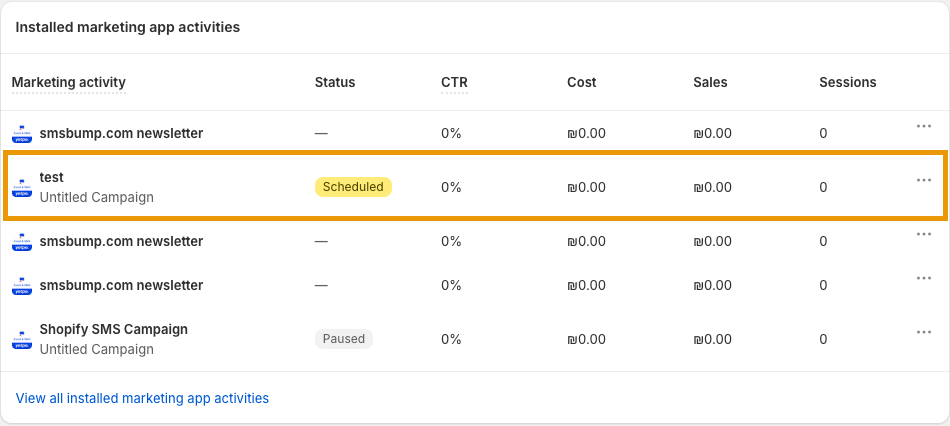
Managing SMSBump campaigns via Shopify marketing
Plus, if you’re already collecting reviews with Yotpo or running Yotpo Loyalty, SMSBump can leverage those (e.g., automatically text a review request or notify a user of loyalty points via SMS). The synergy there is great for those in the Yotpo ecosystem.
SMSBump is also known for being user-friendly. Even non-technical folks can launch campaigns quickly using its templates and straightforward interface. It has useful extras like a free link shortener and built-in link tracking (important because SMS has character limits, so you want short links).
The platform has a strong community of users (since so many Shopify merchants use it) which means lots of shared tactics and even pre-built automations contributed by the community.
In terms of weaknesses, SMSBump might not have all the high-end bells and whistles that a platform like Attentive or even Postscript has. For example, concierge-style services aren’t part of SMSBump’s offering—it’s a bit more self-service. Additionally, being tailored to Shopify is great if you’re on Shopify, but merchants on other platforms (BigCommerce, Magento, etc.) might find the integration less seamless (Shopify is clearly the priority).
Also, because it’s usage-based, very large senders might find the costs add up—at huge scale, having a custom plan or another provider might yield better volume pricing.
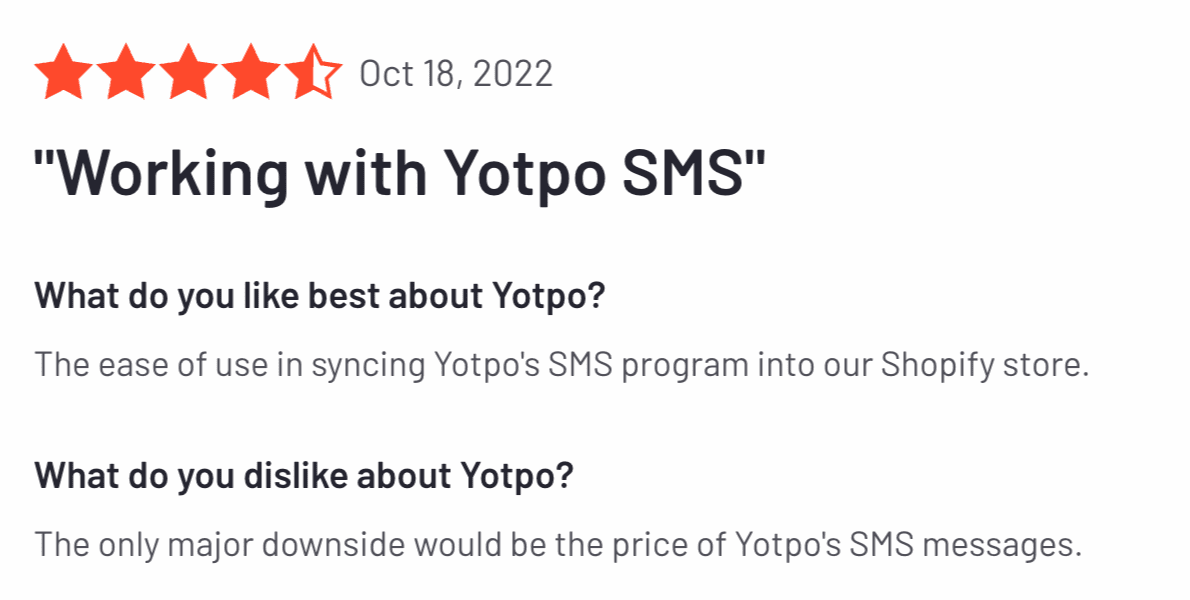
Another aspect: SMSBump’s email integration isn’t the focus, so you’ll be using it alongside an email service and need to coordinate.
Support from SMSBump is generally good via chat/email, but high-touch strategy consulting would only come if you’re a really big client through Yotpo. Lastly, as Yotpo integrates it more, some users fear it could become more expensive or enterprise-y, but so far it remains SMB-friendly.
In summary, weaknesses are mainly that it’s not the most advanced SMS tool in existence (it covers all standard bases, just not a lot of cutting-edge extras) and that it’s very Shopify-centric by design.
Compared to Listrak
For a Listrak user, moving to SMSBump would be a significant shift in approach. Listrak offers SMS in a more integrated way with email, whereas SMSBump is a dedicated SMS platform (meaning you’ll use a different tool for email). If you felt Listrak’s SMS was lacking or too rigid, SMSBump could be a refreshing change—it’s quick to set up new automations, and you don’t need to go through account managers or lengthy processes.
The cost difference could be stark: Listrak likely charged a premium for adding SMS, whereas SMSBump you could start with essentially no fixed cost and just pay a few cents per message. This makes experimenting or ramping up or down very easy.
However, with Listrak you had all data in one place. Switching to SMSBump, you’d want to ensure you sync data (for example, import your Listrak SMS subscribers with proper consent records into SMSBump, integrate your store data so SMSBump knows who purchased, etc.). The good news is, SMSBump on Shopify can pull in purchase data and customer tags easily, so you might actually replicate a lot of what Listrak was doing for SMS fairly quickly.
Feature-wise, Listrak’s SMS and SMSBump overlap on fundamentals (flows, segmentation, etc.). Listrak might have more sophisticated cross-channel triggers (like “if customer didn’t open email, then SMS” types of combined logic), but if you use SMSBump purely for SMS, you can still schedule sends or manually coordinate with email (just not as automatically).
For many smaller brands, Listrak’s cost and complexity wasn’t worth it, and they switch to nimble tools like SMSBump and pair with, say, Klaviyo for email. They often find they save money and still drive great results. On the flip side, a large enterprise that leverages Listrak’s advanced personalization might find SMSBump a bit basic.But since most use cases for SMS are relatively straightforward (abandoned cart reminders, promo blasts, etc.), SMSBump actually covers what 90% of businesses need.
Another point: deliverability and compliance—Listrak provides guidance but expects you to know some of it; SMSBump being a specialist ensures all the carriers’ rules are handled by guiding you through registration in-app and so forth.
In summary, switching from Listrak to SMSBump is like going from a luxury sedan where SMS is one feature in the dash, to a sporty compact car focused on one thing. You gain agility and lower cost, but you might lose some integrated finesse.
If Listrak’s integrated data wasn’t being fully utilized by you, then SMSBump is likely a win. If it was, you’ll need to recreate some connections. But given the cost difference, many find it worth it. Essentially, SMSBump offers a high ROI alternative for the SMS piece, without paying for the whole Listrak package.
Compared to Maestra
Comparing SMSBump to Maestra is similar to comparing other single-focus tools to Maestra’s all-in-one approach. If a brand is using Maestra, they get SMS capabilities within Maestra that would make SMSBump redundant (Maestra can send SMS in its workflows, segment with the same data, etc.). The question is, if someone is considering Maestra, would they instead piece together something like Klaviyo + SMSBump (for example) and achieve similar outcomes?
For smaller brands, yes, SMSBump plus a good email tool can cover a lot of ground and at a lower price than Maestra. In fact, SMSBump often integrates with those email tools (like via Zapier or directly with Klaviyo), so you can semi-coordinate. However, Maestra brings real-time unified data and multi-channel coordination that a combo of separate tools cannot easily replicate in real-time.
For instance, Maestra could have a single customer journey where an email and SMS are intelligently sequenced and decisioned based on live customer behavior in one flow canvas. With SMSBump + another, you’d have to set up an email flow in one tool and an SMS flow in the other and hope they don’t double-contact or miss someone in between—or build a custom integration logic for it.
In terms of features, SMSBump’s feature set for SMS would be pretty comparable to Maestra’s SMS feature set (both do automations, segments, etc.). SMSBump might integrate with Yotpo Loyalty, whereas Maestra has its own loyalty system, but either way you can send loyalty-related texts. The difference is, Maestra’s texts are part of a holistic strategy—e.g., Maestra could decide to send a push notification instead of a text if the user has the app, or give you a unified view of whether a customer clicked an email vs a text. SMSBump exists in its own silo (unless you unify data elsewhere).
Cost-wise, SMSBump is pay-per-use, Maestra is a big flat fee including everything. For a growing brand, Maestra might be more cost-effective when you factor in replacing multiple systems, but for a small brand, SMSBump+others is far cheaper.
Another angle: support and strategy—Maestra, being enterprise-y, includes a success manager to help optimize across channels. SMSBump is more self-serve (Yotpo might have account managers for bigger clients, but typically not to the same depth unless you’re also buying their other products).
So, a brand lacking internal expertise might lean on Maestra’s guidance to run multi-channel campaigns optimally, whereas with SMSBump they’d need to figure out SMS strategy largely on their own or via generic advice.
In essence, Maestra vs SMSBump comes down to scale and integration needs. If you’re at the stage where managing separate tools is impeding your marketing or causing data disconnects, Maestra offers a unified upgrade—albeit at a premium—that eliminates those pain points and adds sophistication. If you’re still at a stage where separate best-of-breed tools (like an email platform + SMSBump) suffice and are manageable, you might not need the big guns that Maestra provides.
Many brands graduate: they might start with Klaviyo+SMSBump, then as they grow and want more capabilities (like onsite personalization, advanced cross-channel logic), they consider moving to Maestra which handles it all together. Neither path is wrong; it’s about the brand’s current needs and resources. SMSBump is an excellent component in a modular stack, whereas Maestra is a one-stop platform for a more complex stack—providing SMSBump’s function plus a lot more under one roof.
Tool #7: ActiveCampaign
Best for: Growing businesses and DTC brands that want a powerful email marketing & marketing automation platform with CRM capabilities, and are open to a bit of tech complexity for greater flexibility (can be used alongside separate SMS tools or with its add-on).
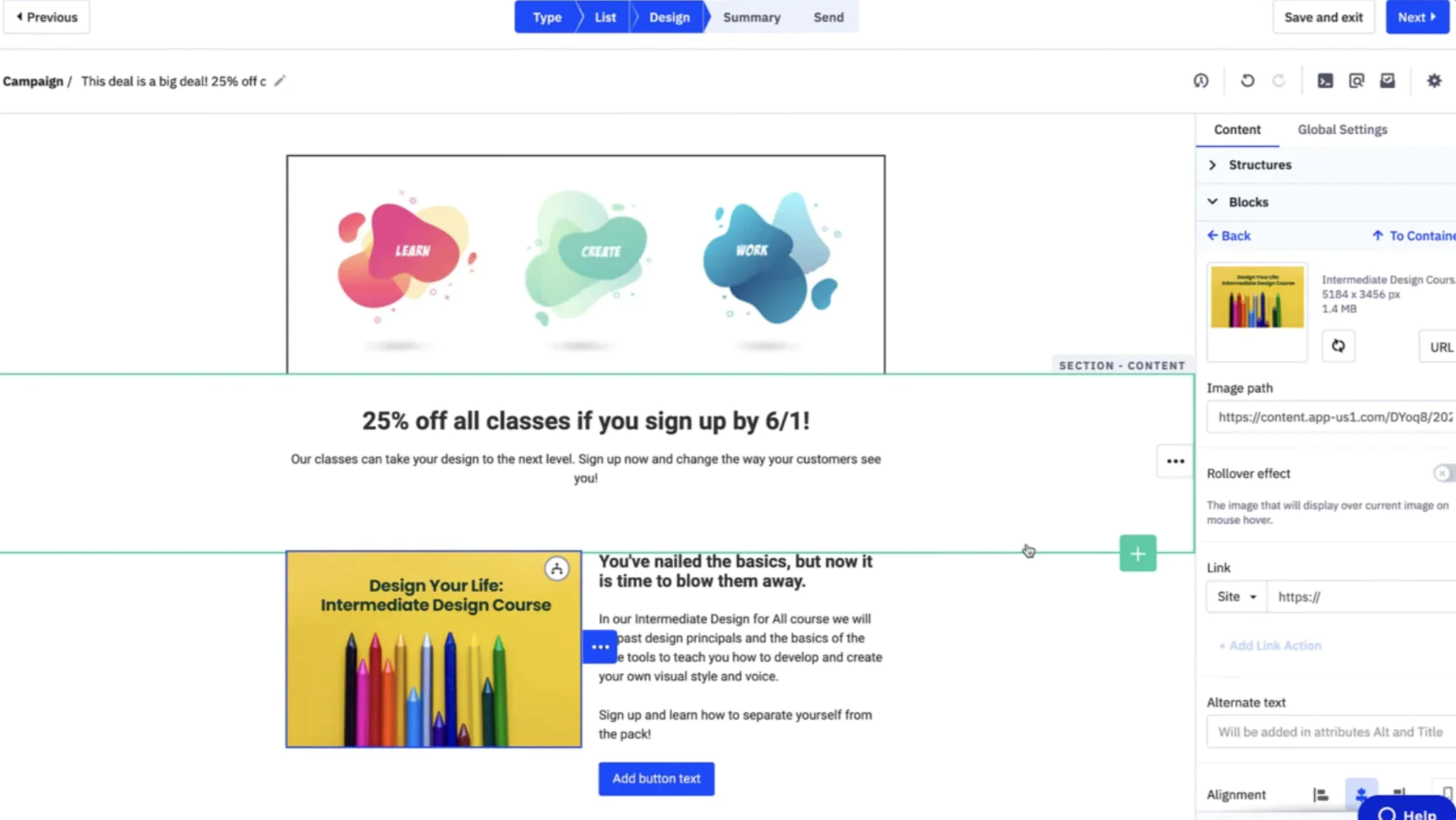
ActiveCampaign’s email composer
ActiveCampaign (AC) isn’t eCommerce-specific like some others on this list, but it’s a widely-used marketing automation platform that many eCommerce marketers consider as an alternative, especially if they want to combine marketing with light CRM functionality.
It’s known for its advanced automation builder and relatively affordable pricing tiers. Many online stores choose ActiveCampaign for its flexibility and because it can serve multiple purposes (email, basic SMS, and customer management). ActiveCampaign can integrate with Shopify and other platforms to pull purchase data, though it might require a bit more configuration.
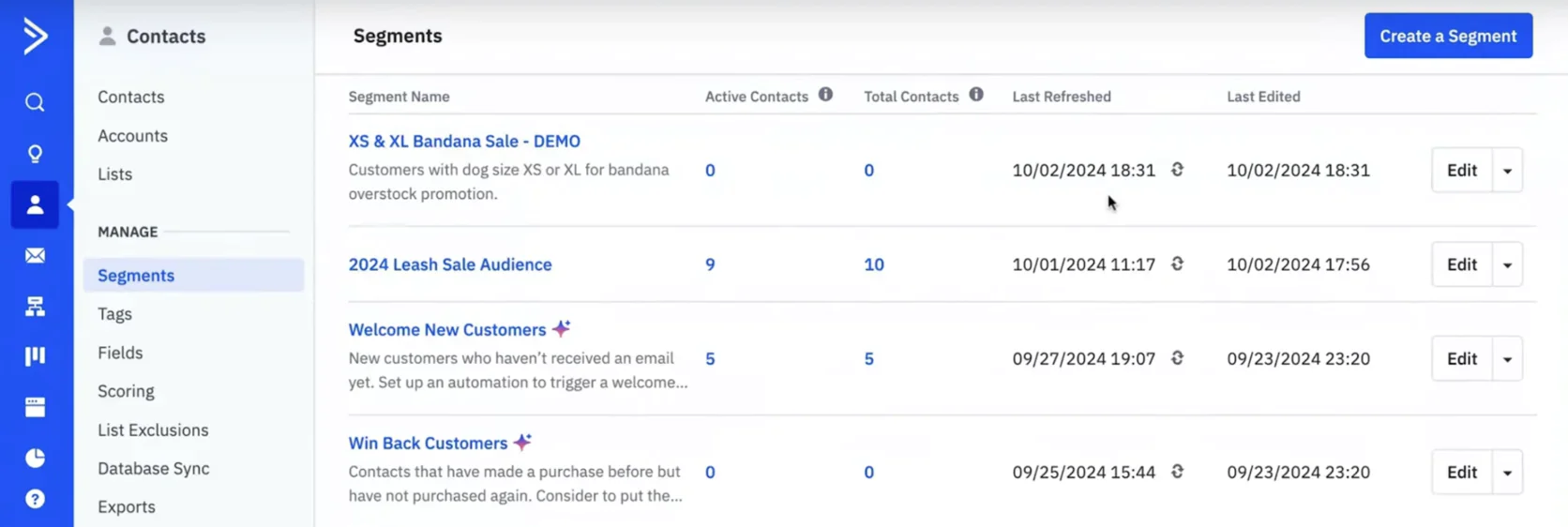
ActiveCampaign’s segments
Key Features:
- Email Marketing: AC offers robust email campaign tools—drag-and-drop email designer, a library of templates, A/B testing for campaigns, dynamic content blocks (if/else content within an email based on contact data), and personalization tags. Deliverability is solid and they have tools to manage that (like automations that filter out unengaged contacts over time).
- Visual Automation Builder: This is ActiveCampaign’s hallmark—a powerful flowchart-style automation builder where you can design customer journeys with various triggers, conditions, and actions (e.g., if user does X, wait Y days, then send email Z or create a task, etc.). It’s extremely flexible, supporting branching, multi-step campaigns that can run indefinitely.
- Built-in CRM & Sales Automation: Unique among this list, AC includes a CRM for managing deals/leads. E-commerce businesses sometimes use this if they have a B2B wholesale side or high-ticket sales that involve follow-up. You can move contacts along a sales pipeline, and the CRM ties into the automation (e.g., when a deal is won, trigger a welcome email series). Not every store needs this, but it’s there.
- Site & Event Tracking: You can embed AC’s tracking code on your site to track page visits and events (like viewing a product or cart). These can then trigger automations. For non-Shopify stores, this is a way to get behavior data into AC. For Shopify, they have a direct integration that syncs orders and product catalog info to AC.
- Segmenting and Targeting: AC has strong segmentation logic—you can build segments using almost any data (email engagement, tags, purchase history, webpage visited, etc.). It also allows conditional content in emails and automations that adjust based on contact attributes.
- Multi-channel (Email + more): ActiveCampaign’s core is email, but it does have the ability to send SMS and even in-app messages or site messages as part of automations. The SMS feature requires an add-on (and is available on higher plans) and is mostly geared toward simple triggered texts (they also integrate easily with third-party SMS providers if you prefer). Additionally, AC can do things like automated Facebook Custom Audience management (add or remove people from ad audiences via automations), which is a neat multi-channel perk.
- Apps & Integrations: ActiveCampaign integrates with tons of other tools—from eCommerce platforms like Shopify, WooCommerce, BigCommerce to helpdesk software, webinar software, etc. There’s also an API, and tools like Zapier have extensive AC connectors, so it fits well in a larger martech stack.
Strengths and weaknesses
ActiveCampaign’s strength is its flexibility and depth of automation. Power users often choose AC because you can create very nuanced automated funnels that other simpler tools can’t do. For example, you could have an automation that on day 30 post-purchase, checks if a customer spent over $200 AND hasn’t left a review, and if so, triggers a series that first sends an email asking for a review and then waits and maybe sends an internal alert to your team if no review comes, etc.
That level of multi-step logic is AC’s playground. It’s also fairly cost-effective for what it offers: plans start around $29/month for basic (with 1,000 contacts), which is cheaper at that level than Klaviyo. Even as you scale, AC’s pricing tends to be competitive for the features (though it adds up with more contacts and if you upgrade for add-ons like SMS or CRM seats).
Another strength is that AC can serve multiple business types; if your brand also does some B2B or runs events, AC can manage those communications and pipelines in one system, whereas an eComm-specific tool might not handle non-eComm use cases well. AC’s deliverability and support are generally well-regarded, and they have a lot of online resources and an active community forum.
On the downside, ActiveCampaign can be complex. With great power comes a slightly steeper learning curve. New users might find the interface a bit overwhelming because there’s so much you can do (automations, campaigns, deals, lists, tags, etc.).
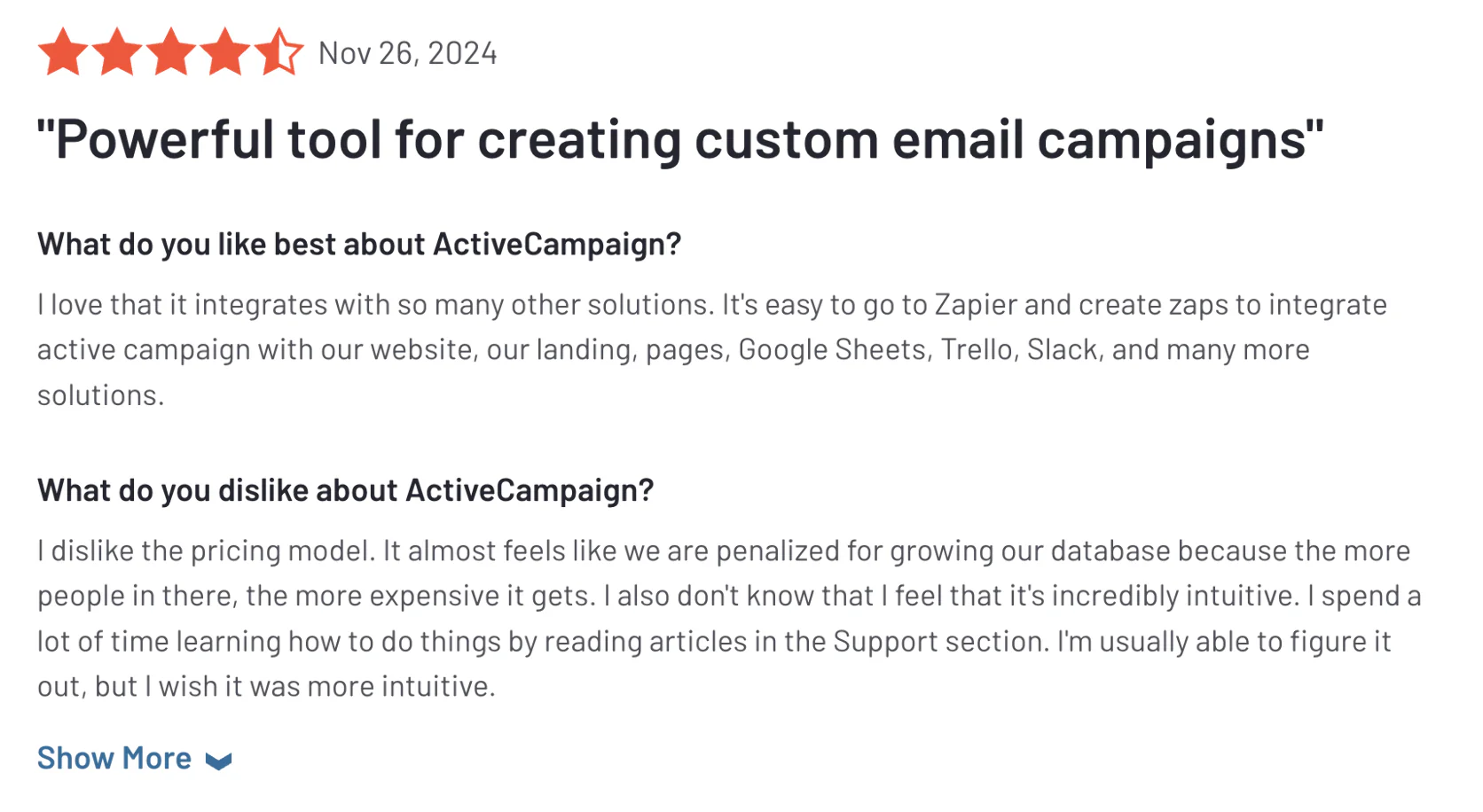
It’s not as plug-and-play as, say, Omnisend for eCom specific needs—you have to set up some things yourself (like creating the exact automation flows you want, whereas Omnisend might pre-load an abandoned cart flow for you).
ActiveCampaign also doesn’t have native visual appeal for eCommerce use like product pickers in emails; you have to manually design emails or integrate your product feed via custom code or integration.
In terms of SMS, AC’s built-in SMS is limited and only available on higher plans or as an add-on. Many AC users opt to integrate a dedicated SMS service instead, which is an extra step. So if SMS is a big part of your marketing, AC alone might fall short unless you invest in the add-on (and even then, it’s not as feature-rich as SMSBump or Attentive).
Another weakness: AC doesn’t have specific features like loyalty program management or review solicitations built-in; you’d have to integrate those. So it’s not an all-in-one marketing suite in the way Maestra or even Listrak aim to be; it’s more focused on communications and customer data, not on-site elements.
Compared to Listrak
Listrak vs ActiveCampaign often boils down to enterprise suite vs nimble automation tool. Listrak is more of a turnkey solution for retailers—it has a lot of features out-of-the-box (some might say too many if unused) and comes with a higher price tag and usually some account management.
ActiveCampaign is more self-service and modular. For a mid-market retailer that found Listrak too cumbersome or expensive, ActiveCampaign can achieve similar outcomes (at least for email marketing) with more flexibility and at a lower cost. However, AC will require more hands-on work to integrate and set things up to match what Listrak might have pre-configured.
For example, Listrak might have an AI product recommendation block you can drag into an email—with AC, you’d integrate a recommendation engine or manually craft your rec logic via data.
One big difference is real-time data handling. Listrak’s platform is built for retail, so things like catalog updates, inventory triggers, etc., are part of it. AC can do triggered emails based on events (like an API call when inventory is low or similar), but it might need more custom setup.
If you rely on things like predictive analytics from Listrak (predicting optimal send time, or likelihood to purchase), AC doesn’t natively offer that, though you can manually use its scoring feature to approximate some behavior scoring.
On the flip side, AC’s CRM and sales automation could be a boon if Listrak lacked any way for you to manage leads or wholesale clients—Listrak doesn’t do CRM pipelining, AC does.
Cost-wise, ActiveCampaign is almost certainly cheaper until you have a very large database. And even then, AC’s highest tiers (which can be several hundred a month) often remain less than a Listrak contract. So a lot of brands consider AC when they want to save money but not drop to a very basic tool. It provides a middle ground of robust functionality at a mid-level price.
Support: Listrak may provide more personalized support (especially if you’re a big client), whereas AC’s standard support is via tickets/chat unless you’re enterprise. But AC’s user community often fills that gap with shared recipes and advice.
If a company is leaving Listrak due to lack of certain features like CRM or wanting multi-purpose use, AC clearly wins there. But if one is leaving because they want something tailor-made for eCommerce with less fuss, AC might or might not be the best depending on the user’s comfort with building out automations. Many agencies or marketers enjoy AC because of the control it gives.
In summary, ActiveCampaign can replicate much of Listrak’s email/SMS marketing functionality (with some help from add-ons) and do it cheaper, but it won’t replicate some niche eCom features (loyalty, advanced AI, etc.) that Listrak has. It’s a trade-off between cost/flexibility and specific feature depth. For many mid-sized brands, AC’s flexibility is actually a win because they can customize their marketing operations more freely than within Listrak’s preset structure.
Compared to Maestra
Maestra and ActiveCampaign both can handle multi-channel marketing.
If you compare feature by feature, Maestra has a lot that AC doesn’t—native loyalty programs, on-site personalization, a unified CDP with real-time triggers, etc. ActiveCampaign provides some pieces of that via integrations. ActiveCampaign requires assembling an ecosystem of apps (loyalty platform, personalization engine, SMS platform, etc.) and then connecting them to AC. Maestra offers all that in one place, which is a big simplicity and capability gain (with a matching big price).
However, for a brand that doesn’t need the full Maestra suite or can’t afford it yet, ActiveCampaign could be part of a more budget-friendly alternative stack.
In terms of automation power, ActiveCampaign is actually on par Maestra in pure complexity of logic—you can craft extremely complex automations in AC.
Maestra’s advantage is the data it has to feed those automations and the channels it can automate beyond just email/SMS. AC’s CRM might be irrelevant to a DTC brand but crucial to one that has a B2B side—Maestra doesn’t really focus on CRM for sales teams. So if that’s a need, AC wins there.
Support and service: Maestra includes a lot of guidance and even managed services in onboarding. With AC, unless you pay for their higher tiers or a consultant, you’re largely self-driven. A well-resourced marketing team might not mind that, but a smaller team might find Maestra’s support very helpful.
Also consider scalability: AC can technically scale to millions of contacts (they have enterprise clients), but an eCommerce giant might push AC’s limits in terms of real-time responsiveness. Maestra’s infrastructure is tailored for fast eCom triggers (like browse abandonment in seconds). AC’s triggers might have slight delays (minutes) or need custom event setup.
When comparing AC to Maestra for someone looking at alternatives to Maestra, it usually comes down to budget and needed scope. If Maestra is affordable and you want everything integrated (and are okay with its fixed structure), Maestra is more convenient and powerful in aggregate. If Maestra is overkill or too costly, AC is part of a modular approach to cover your needs.
Summary: Choosing the Right Listrak Alternative
As we’ve seen, there is no one-size-fits-all replacement for Listrak—the best alternative depends on your business size, channels of focus, and the pain points you’re trying to solve.
If you’re a smaller eCommerce store tired of Listrak’s high costs, platforms like Omnisend or SMSBump can cover your email and SMS needs at a fraction of the price, with a gentler learning curve.
For brands that found Listrak’s capabilities limiting or its interface clunky, Klaviyo offers a modern, data-driven experience especially tailored to Shopify-centric merchants, while ActiveCampaign provides a more customizable automation engine for those who want CRM features or deeper multi-step flows.
If SMS marketing is where you felt Listrak under-delivered, a specialist like Postscript (or Attentive for bigger budgets) will supercharge that channel and engage customers where they’re most responsive.
And for mid-market and enterprise brands that simply want a better all-in-one—one that’s more agile, service-oriented, and innovative—Maestra stands out as the next-generation platform to elevate your marketing. It combines the best of what these other tools offer (omnichannel reach, advanced personalization, cost efficiency at scale) into one coherent system.
In the end, decision-makers should consider both their immediate needs and their long-term growth. Some may opt for a lean stack of multiple best-of-breed tools to save cost now, knowing integration is required; others may consolidate into a single powerhouse platform to build a strong foundation for the future.
If you’re leaning towards an all-in-one solution that is modern, affordable, and user-friendly, we encourage you to give Maestra a try and book a demo right now.
It’s designed to address exactly the challenges that lead marketers to seek Listrak alternatives—from simplifying campaign management to cutting out needless costs. With Maestra, you can future-proof your email and SMS marketing (and beyond) on a single platform that grows with your brand.
Don’t settle for the status quo—try out Maestra and see the difference a next-gen marketing platform can make for your business.
